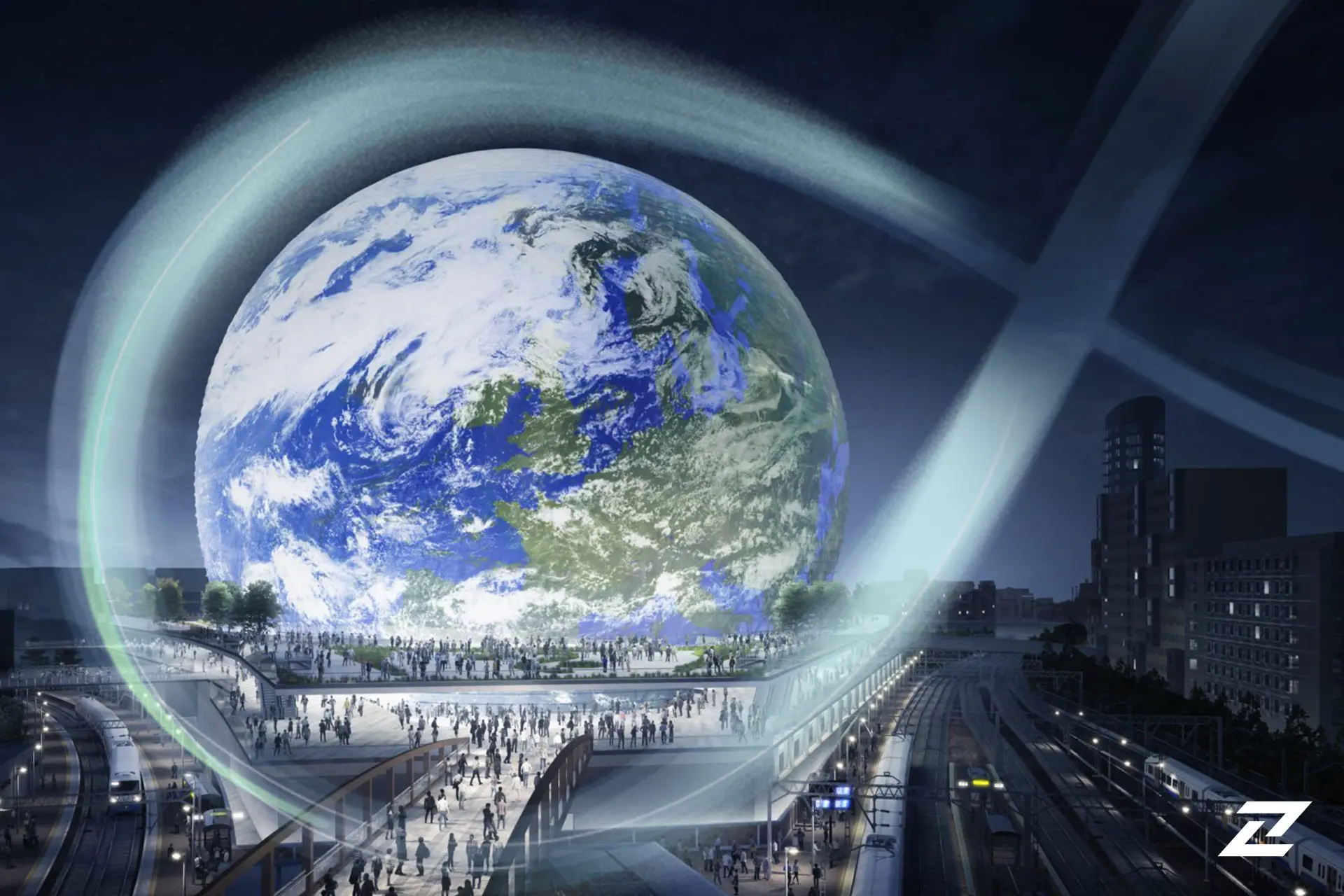Technology
The planet Saturn; Features, number of moons, rings and wonders
Published
3 months agoon


The planet Saturn; Features, number of moons, rings, and wonders
Saturn is the sixth planet in terms of distance from the Sun and the second largest planet in the entire solar system. Saturn can be called the lord of the rings of the solar system due to its thousands of beautiful and unique rings. Like Jupiter, this planet is a gas giant with a radius 9 times that of Earth, while its density is one-eighth that of Earth.
Saturn’s internal structure is a mixture of iron, nickel, and rock (silicon and oxygen compounds). The core of the planet is surrounded by a layer of metallic hydrogen, the middle layer consists of liquid hydrogen and helium, and finally there is a gaseous outer layer. The reason for Saturn’s soft yellow color is the presence of ammonia crystals in its upper atmosphere. The electric current inside the metallic hydrogen layer has increased the magnetic field of this planet. The strength of Jupiter’s magnetic field is twenty-one times that of Saturn. The outer atmosphere of this planet is calm and without turbulence. The wind speed in some areas of Saturn reaches 1800 km/h, which is more than Jupiter.
From the collection of articles on the introduction of planets: The planet Mars; Everything you need to know
So far, at least 83 moons have been discovered in the orbit of Saturn, 53 of which have been officially named. The largest moon of Saturn, Titan, is the second largest moon in the solar system and is even larger than the planet Mercury. Titan is the only moon in the entire solar system that has a significant atmosphere. The most striking feature of Saturn is its ring system, which is a combination of ice particles and small pieces of rock.
-
What does the planet Saturn symbolize?
-
How was the planet Saturn formed?
-
Nucleus aggregation model
-
Disk instability model
-
Saturn is how many times the size of Earth?
-
Physical characteristics and internal composition of the planet Saturn
-
Saturn’s atmosphere and clouds
-
Saturn’s magnetic field
-
The orbit and rotation of Saturn
-
Rings of Saturn
-
How many moons does Saturn have?
-
Grouping of Saturn’s moons
-
Irregular moons
-
Alkeonides
-
Titan
-
The potential for life on Titan
-
Enceladus
-
Iaptus
-
Hyperion
-
Mimas
-
Pan and Atlas
-
Rhea
-
debt
-
Tethys
-
The wonders of the planet Saturn
-
Seeing Saturn from Earth
-
Discoveries of Saturn in the Space Age
-
Pioneer discoveries 11
-
Voyager 1 and 2 discoveries
-
Cassini Huygens: Exploring the Saturn System
-
Farewell to Cassini
-
Future missions to Saturn
What does the planet Saturn symbolize?
The observation of the planet Saturn has a prehistoric age and has been recorded in myths since the first observation. Babylonian astronomers systematically observed Saturn and recorded its movements. The planet Saturn is known as Phainon in ancient Greece and as Saturn in Roman mythology.
Saturn is the Roman god of agriculture and equivalent to the Greek god Kronos, one of the Titans and the father of Zeus. The symbol of the planet Saturn is the scythe. Because Saturn is the god of agriculture and also time, this symbol is represented by a shape similar to the Greek letter eta, with a cross-like shape added on top of it, meaning the scythe of the gods. The Romans named the seventh day of the week Saturday, which stands for Saturn’s Day, and this day is named after this planet.

How was the planet Saturn formed?
Like other planets in the solar system, Saturn was formed from a solar nebula approximately 6.4 billion years ago. This nebula was a large cloud of cold gas and dust, which was probably formed by the impact of a supernova cloud or wave.
In general, there are two theories about the formation of planets in the solar system. The first and most acceptable theory is the core accretion theory, which is very close to reality in the case of rocky planets but faces problems in the case of gas giants such as Saturn. The second theory, the disc instability theory, could be true for gas giants.
Nucleus aggregation model
Approximately 6.4 billion years ago, the solar system was a cloud of gas and dust called the solar nebula. Gravity caused matter to begin to rotate. At the center of this rotation, the sun was created. With the emergence of the sun, the remaining materials joined together. Smaller particles were transformed into larger particles by the force of gravity. The solar winds carried smaller elements such as hydrogen and helium away from the regions near the sun, and in this way, heavy and rocky materials near the sun led to the formation of rocky worlds.
But at a further distance, the solar winds had less effect on the lighter elements, and thus gas giants like Saturn were born. Meteorites, comets, planets, and moons were formed in this way. It can be said that the planet Saturn is almost completely composed of light hydrogen gas, and of course, a significant part of it is helium. A small trace of other elements can be seen in its atmosphere. Saturn must have a large core to absorb these gases in this model. Thus, the gravity of the heavy core has attracted the lighter elements before they are blown away by the solar wind.
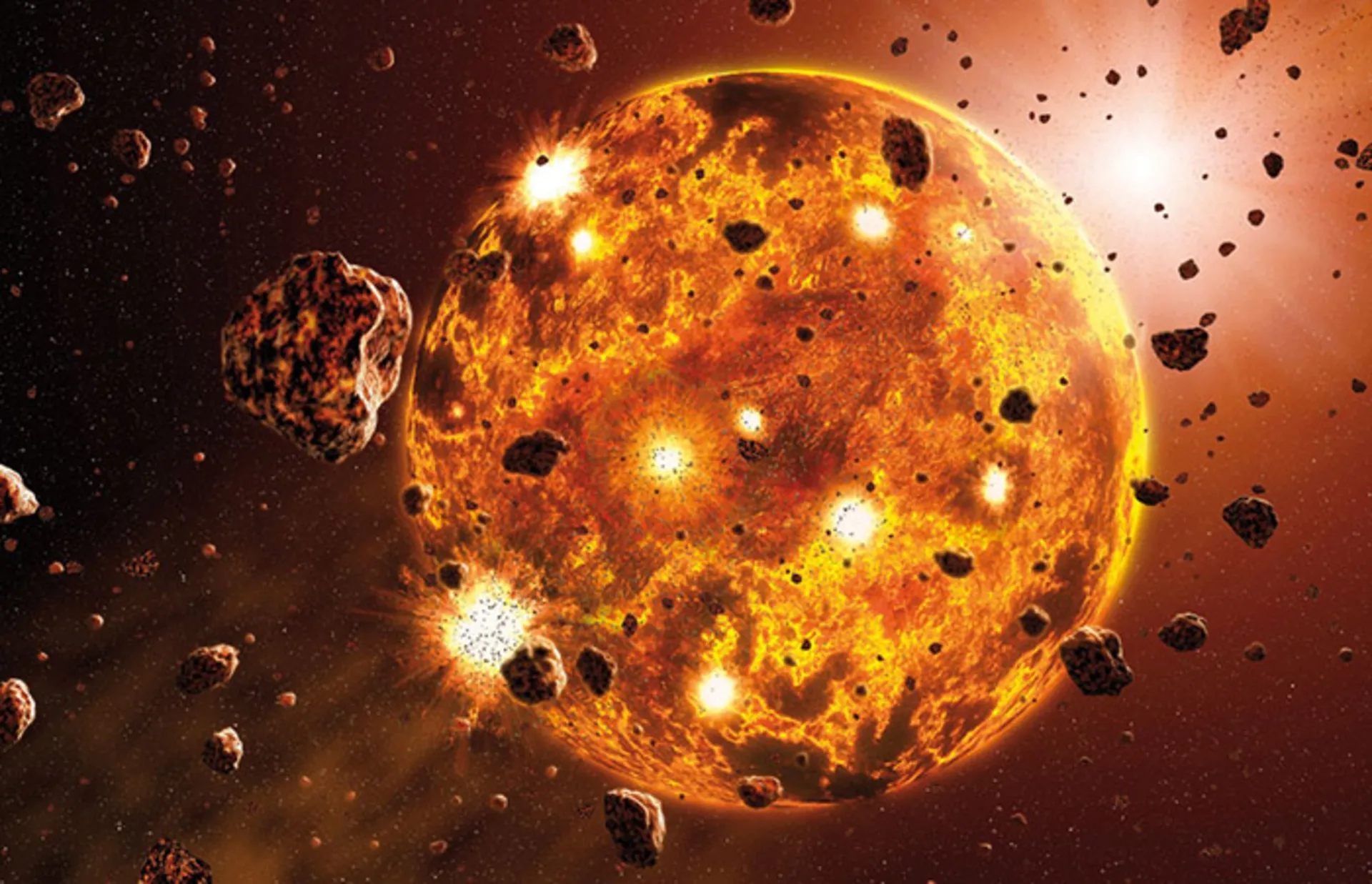
Disk instability model
However the need for a short time for the formation of gas giants is one of the problems of the core accretion model. According to the models, this process takes millions of years in the nuclear accumulation model. At the same time, the core accretion model also faces the problem of planetary migration, because small planets were placed in orbit around the Sun in a short period of time.
According to a relatively new theory known as disk instability, masses of gas and dust have joined each other in the early life of the solar system, and over time these masses have been compressed and formed gas giants. These planets are formed faster than their counterparts in the core accretion model, and their formation time even reaches several thousand years.
Saturn is how many times the size of Earth?
Saturn has 760 times the volume of Earth, it is the second heaviest planet in the entire solar system and has 95 times the mass of Earth. Saturn has the lowest density among the planets of the solar system. The density of this planet is even lower than water so if we drop Saturn in a large enough ocean, it will float on its surface.

Saturn accommodates 760 Earths
Physical characteristics and internal composition of the planet Saturn
Hydrogen and helium are the dominant elements of Saturn, hence this planet is a gas giant. Like Jupiter, Saturn does not have a defined surface, although it may have a solid core. The rotation of the planet Saturn has made the shape of this planet widen at the poles and rise at the equator.
According to standard planetary models, the internal structure of Saturn is similar to the internal structure of Jupiter; It means a rocky core in the center surrounded by hydrogen and helium. The composition of Saturn’s core is similar to Earth’s, but it is more dense. In 2004, scientists estimated the mass of Saturn’s core to be 9 to 22 times that of Earth. Saturn’s core is surrounded by a thick layer of liquid metallic hydrogen, after this layer there is a liquid layer of molecular hydrogen, which gradually enters the gas phase with increasing altitude. The outermost layer is located at an altitude of 1000 km and consists of gas.
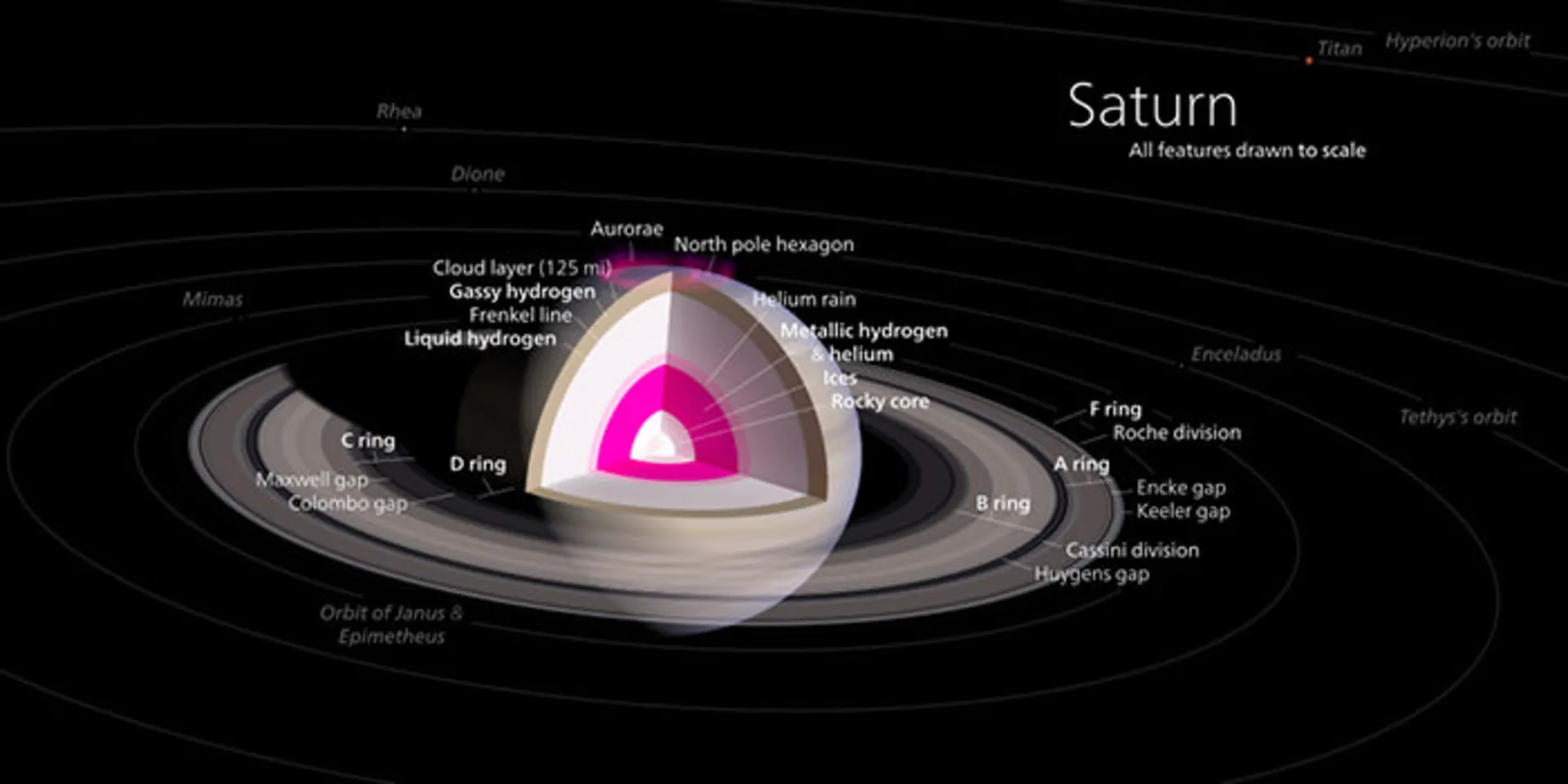
Composition diagram of Saturn: A layer of liquid hydrogen surrounds the core of this planet
The interior of Saturn is very hot and the temperature of its core reaches 11,700 degrees Celsius. Saturn releases 2.5 times the energy received from the Sun into space. Jupiter’s thermal energy is based on Kelvin Holmholtz’s slow gravitational compression mechanism (this mechanism occurs when the surface of a star or planet cools. The cooling process reduces the pressure and the star or planet shrinks), but this process is not sufficient to describe the heating of Saturn. . Another mechanism of heat production is the precipitation of helium droplets in the depths of Saturn. As the droplets fall on the low-density hydrogen, heat is released.
Saturn’s atmosphere and clouds
Saturn’s outer atmosphere contains 3.96% of molecular hydrogen and 25.3% of helium. In general, 75% of Saturn is hydrogen and 25% is helium and traces of other substances such as methane and frozen water can be found in its atmosphere. Amounts of ammonia, acetylene, ethane, propane, phosphine, and methane have also been discovered in Saturn’s atmosphere. The upper clouds are composed of crystalline ammonia, while the lower clouds are composed of ammonium hydrosulfide or water.
Although Saturn’s atmosphere is very similar to Jupiter’s, it appears uniform from a distance. Saturn’s atmosphere has a banded pattern similar to Jupiter’s. These bands become wider near the equator. The composition of clouds in different areas changes according to height and pressure increase. Saturn is one of the windiest places in the entire solar system and the wind speed in its equatorial regions reaches 1800 km/h. The yellow and gold bands in Saturn’s atmosphere are the result of super-fast winds in the planet’s upper atmosphere. Ultraviolet rays lead to the process of photolysis or photolysis in the upper atmosphere of Saturn, which leads to a series of hydrocarbon reactions. Saturn’s photochemical cycle also changes based on its seasonal cycle.
Saturn ranks second in terms of wind speed in the solar system
Saturn ranks second in terms of wind speed in the solar system after Neptune. Sometimes intense white storms disrupt the cloud layers. One of these storms was observed by the Hubble Space Telescope in 1994. To understand the characteristics of Saturn’s atmosphere, it is better to compare it with Earth. The atmosphere of Earth and Saturn have a major difference in terms of atmospheric pressure.
The radius of the planet Saturn is approximately 9 times the radius of the Earth, and the pressure increases as it penetrates into the deeper layers of the atmosphere. NASA’s observations of this planet show that the pressure of Saturn near the core is 1000 times the pressure on Earth, and this pressure is enough to convert hydrogen into liquid and then solid metal in the planet’s core. Atmospheric pressure levels common on Earth can only be found in the upper regions of Saturn’s atmosphere, where the ammonia ice clouds are located. The temperature of Saturn’s atmosphere varies from minus 130 degrees to plus 80 degrees Celsius.
Saturn’s magnetic field
Saturn has an internal magnetic field with a symmetrical and simple shape. Saturn’s magnetosphere is much smaller than Jupiter’s magnetosphere. The rings and many of Saturn’s moons are also within this magnetosphere, in this region the behavior of charged particles is more influenced by Saturn’s magnetic field than the solar wind.
The aurora phenomenon occurs when charged particles spiral in the planet’s atmosphere along the lines of the magnetic field. On Earth, these charged particles originate from the solar wind. Cassini showed that at least some of Saturn’s auroras are similar to Jupiter’s auroras and are not affected by the solar wind.
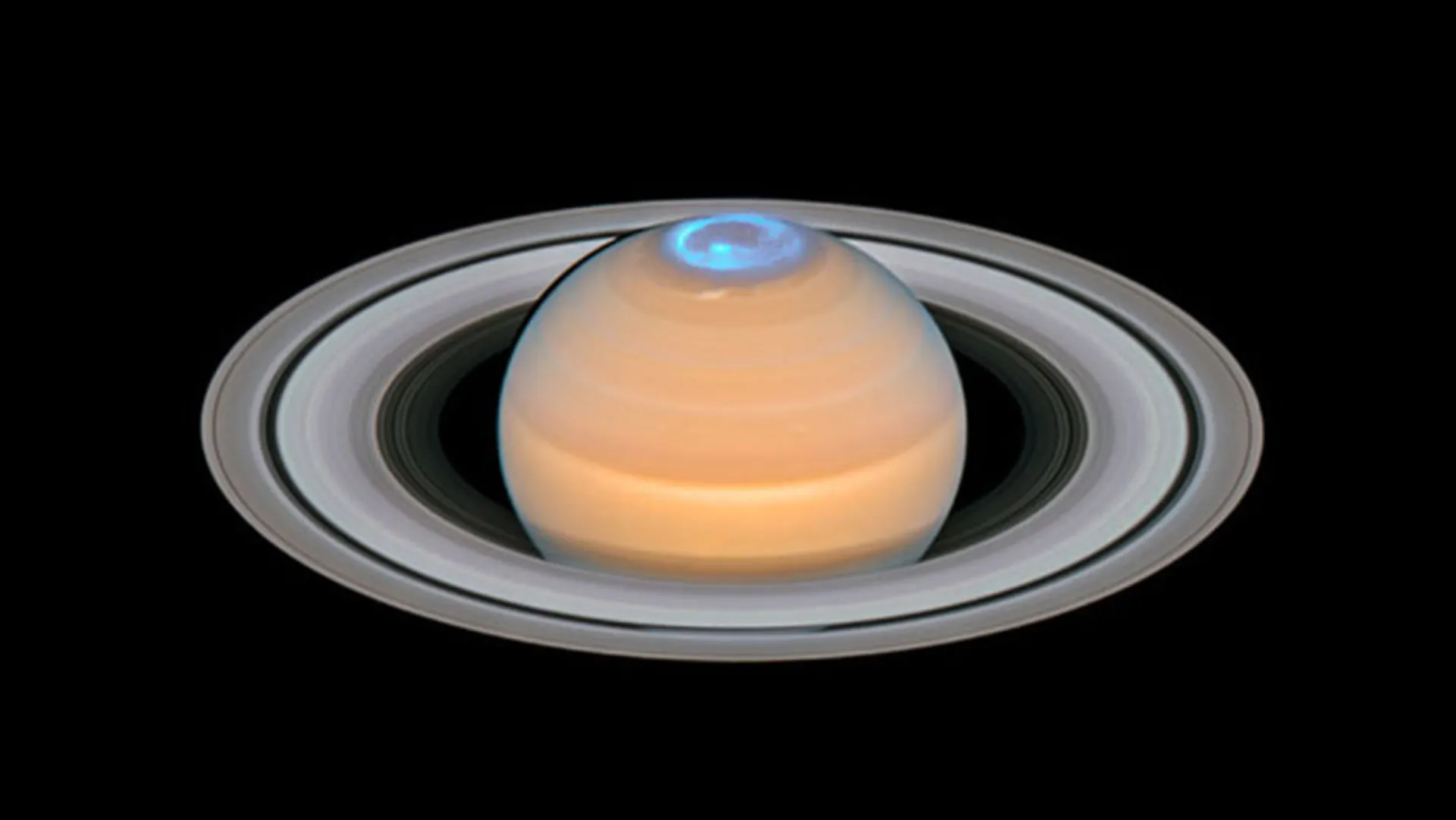
Saturn’s auroras are similar to Jupiter’s auroras
The orbit and rotation of Saturn
Compared to Earth, Saturn’s orbit around the Sun is slow, but its orbit around itself is faster. Saturn orbits the Sun at a speed of approximately 35,400 km/h. This speed is about one-third of the speed of the Earth’s movement around the sun. The length of Saturn’s year during a complete period of rotation around the Sun is equal to 29.5 years or 10,755 Earth days.
Although the movement of Saturn around the Sun is slow, its movement around its axis is much faster than that of the Earth, and it completes its rotation in less than half an Earth day. Because Saturn is about 10 times the diameter of Earth, any point on its equator moves 20 times faster than the corresponding point on Earth’s equator. This rapid rotation causes Saturn to form an oval shape so that it becomes flat at the poles and wide at the equator. Saturn’s day is equal to 10 hours and 38 minutes on Earth.
In 2007, it was found that the changes in radio emissions from Saturn do not correspond to its rotation speed. This variance may have occurred due to geyser activity on Saturn’s moon Enceladus. In this way, the water vapor released in the orbit of Saturn is charged and as a result, they cause stretching in the magnetic field of Saturn, and thus the rotation of the magnetic field becomes slower than the rotation of the planet itself.
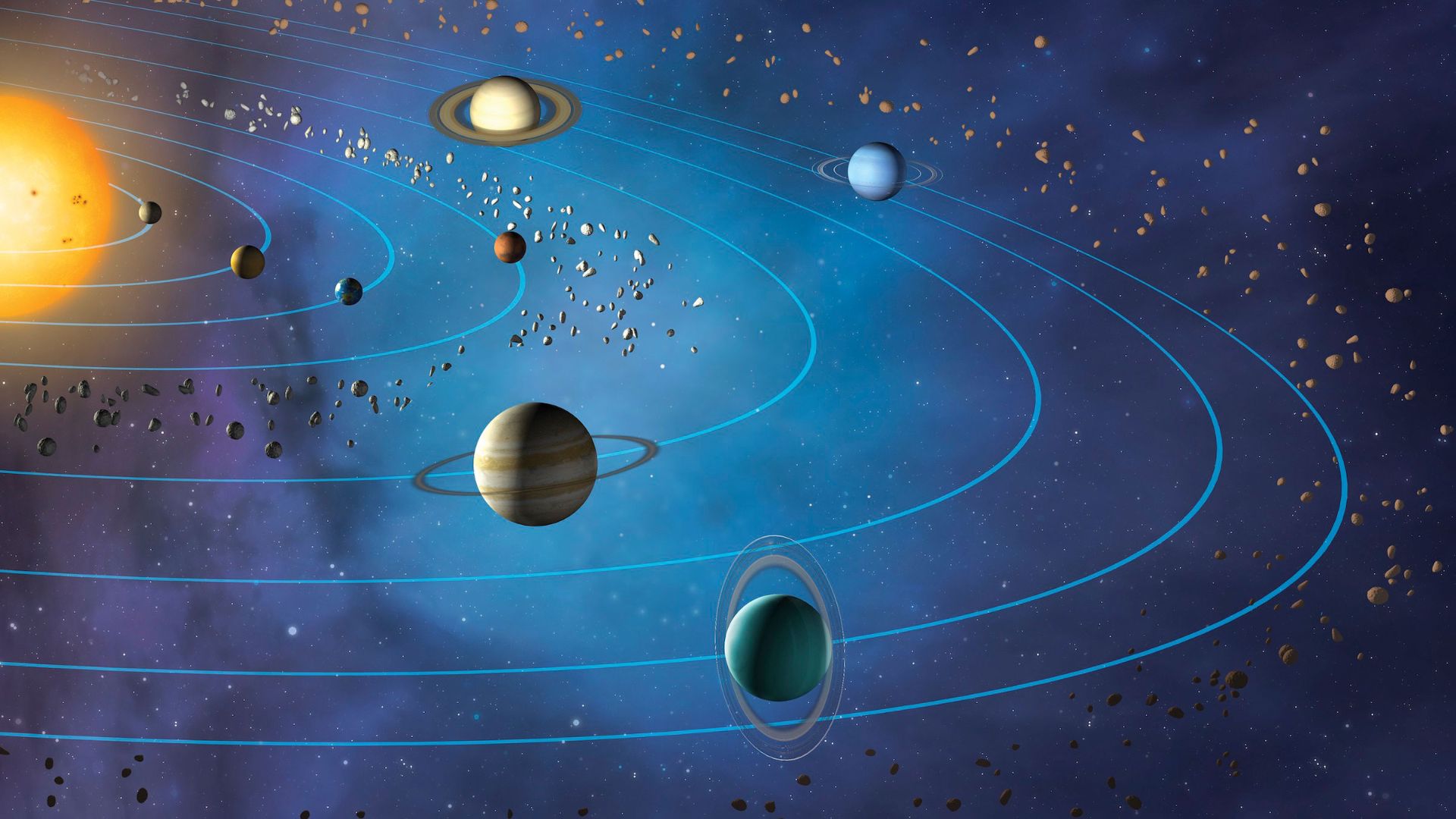
Rings of Saturn
Saturn’s prominent and bright rings make it a unique planet in the entire solar system. Saturn’s rings have fascinated astronomers for centuries. When Galileo first observed Saturn in 1610, he thought the rings were large moons on either side of the planet. During his seven years of observation and exploration, he recorded the rings changing shape and even disappearing (depending on the angle and declination with the Earth). ).
According to Galileo’s observations, Saturn’s equator has a 27-degree deviation from its orbit around the Sun (similar to the 23-degree deviation of the Earth). As Saturn revolves around the Sun, first one hemisphere and then the other hemisphere are facing the Sun. This deviation causes seasonal changes (similar to Earth) and when Saturn reaches the equinox, the equator and plane of the ring are aligned with the Sun. Sunlight hits the edges of the ring. The rings are generally 273,600 km wide, but only 10 meters thick.

In 1655, another astronomer, Christian Huygens, proved solid ring objects, and in 1660, another astronomer suggested that the rings were composed of satellites or small moons (a view that remained unconfirmed for 200 years).
In the modern era, Pioneer 11 passed through Saturn’s ring in 1979. In the 1980s, Voyager 1 and Voyager 2 investigated the planet’s ring system. In 2004, NASA’s Cassini Huygens mission became the first probe to enter Saturn’s orbit, recording detailed observations not only of the planet itself but of its ring system.
Saturn’s rings are made of billions of particles ranging from sand to large objects the size of mountains. Most of the particles are made of frozen water. When you look at Saturn with an amateur telescope, its ring appears to be one piece, but this ring is actually made up of several parts. The rings are named in order of discovery, so the main rings are named A, B, and C from farthest to closest. The width of the A gap is approximately 4700 km, which is also called the Cassini segment. This gap separates the A and B rings.
Other narrower rings were discovered as telescope technology improved. Voyager 1 discovered the innermost ring called D in 1980. The F ring is also placed outside the A ring. In contrast, the G and E rings are even further apart. The rings themselves are composed of a number of gaps and distinct structures. Some of them are very small moons of Saturn, while others confuse astronomers. Saturn is not the only planet in the solar system that has a ring system. Jupiter, Uranus, and Neptune also have rings, but Saturn’s ring is the most prominent type of ring.
There are different hypotheses about the formation of Saturn’s rings. Some scientists think that comets or passing meteorites are trapped by Saturn’s gravity and disintegrated before reaching it. The reason for the high brightness of Saturn’s rings is that a large part of the rings are made up of particles and ice pieces. The size of these particles varies from small pieces to large icebergs. These ice particles in Saturn’s rings form ice clusters and reflect a lot of light.
Another possibility suggests that the rings were once large moons orbiting the planet. Saturn has at least 83 moons. Only one of its moons, Titan, is a large moon. The rest of the moons are small objects and only 13 of them are more than 50 km. The gravity of these moons affects the structure of Saturn’s rings while providing clues about how the rings formed.
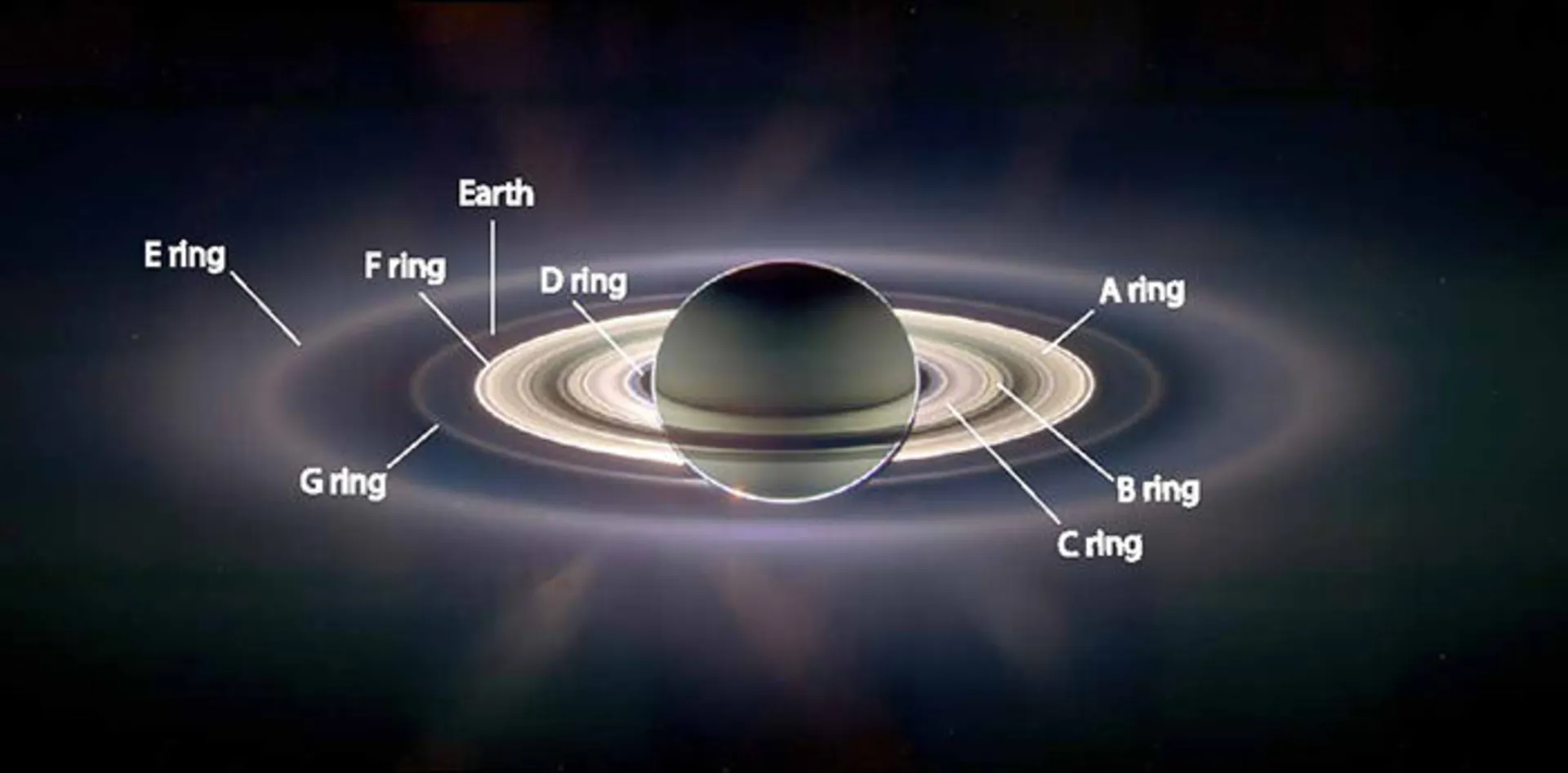
How many moons does Saturn have?
The planet Saturn has a large number of diverse moons, ranging from satellites with a diameter of tens of meters to large moons like Titan with dimensions larger than the planet Mercury. Saturn has 83 confirmed moons, only 13 of which have diameters greater than 50 km. Titan is the most prominent moon of Saturn and the second largest moon in the Solar System after Ganymede (Jupiter’s moon). The moon’s atmosphere, like Earth’s, is full of nitrogen and offers views of river networks and hydrocarbon lakes.
Twenty-four moons of Saturn are regular satellites and their progressive orbits are not inclined to Saturn’s equatorial plane. These twenty-four moons include seven main satellites, four small moons, two small co-orbiting moons, and two other moons that act as shepherds of Saturn’s F ring. The remaining 58 moons, which have a diameter varying from 4 to 213 km, are among the irregular moons whose orbits are at a greater distance from Saturn. These moons are probably trapped planets or parts of collapsed bodies after being trapped. Irregular moons are divided into Inuit, Norse, and Gaelic groups based on orbital characteristics. The names of these groups are taken from Greek mythology. The largest irregular moon Phoebe is the ninth moon of Saturn, which was discovered at the end of the 19th century. Saturn’s rings are a combination of microscopic variable bodies to satellites several hundreds of meters in diameter, each orbiting Saturn in its own orbit.
It is believed that the moon system of the planet Saturn was formed similar to the moons of the planet Jupiter, but in general, the details of the formation of the moons of Saturn are unclear. On June 23, 2014, NASA reported strong evidence that the nitrogen in Titan’s atmosphere came from material in the Oort Cloud, not from Saturn.
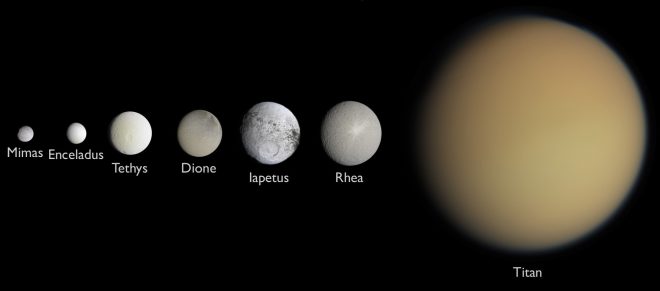

Comparison of Saturn’s moons in terms of size
Grouping of Saturn’s moons
Although the demarcation of Saturn’s moons is somewhat vague, they can be divided into ten groups based on their orbital characteristics. Many of these moons, including Penn and Daphnis, are in Saturn’s ring system, and their orbital period is slightly longer than that of Saturn. Inner moons and regular moons have an average orbital inclination ranging from 1° to 1.5°. On the other hand, the irregular moons in the outermost part of Saturn’s moon system, especially in the Norse group, have orbital radians of millions of kilometers and orbital periods of several years. The Norse moons also orbit Saturn in the opposite direction.
- Large inner moons: Saturn’s innermost large moons are located in Saturn’s thin E ring. These moons are Mimas, Enceladus, Tethys, and Dione.
- Large outer moons: These moons are located on the other side of the E ring, they are: Rhea, Titan, Hyperion, Iapetus
Irregular moons
Irregular moons are small satellites with high radians and inclinations and are thought to have been caught in Saturn’s gravitational trap in the past. The exact size of these moons is still unknown because their dimensions are so small that they are difficult to observe with a telescope.
Alkeonides
The three small moons between the moons of Mimas and Enceladus are called Alkeonids, which derives its name from Greek mythology. These three months are Matun, Ant, and Plan. Ant and Meton have a very thin circular arc in their orbit, while Plan has a completely thin ring. Among these moons, only Matun was photographed from a relatively close distance. This egg-shaped moon has a small number of impact craters.
Titan
Titan is the largest moon of Saturn and the second largest moon in the solar system (after Jupiter’s moon Ganymede). Titan is the only moon in the solar system with a dense and cloudy planet-like atmosphere. Scientists believe that the conditions on Titan are similar to the initial conditions on Earth, but the only difference is that the Earth is closer to the Sun and it is hotter. In many ways, Titan is the most similar to Earth.
Titan’s diameter reaches 2,575 km, which is almost 50% wider than the Earth’s moon. The distance between Titan and Saturn is about 1.2 million kilometers and 1.4 billion kilometers or 9.5 AU from the Sun. An astronomical unit is the distance from the Earth to the sun. It takes about 80 minutes for sunlight to reach Titan because of this distance, sunlight is about 100 times dimmer than sunlight on Earth.
It takes approximately 15 days and 22 hours for Titan to complete one orbit of Saturn. Titan is tidally locked to Saturn, which means that, like Earth’s moon, one side of it is always seen from Saturn. It takes approximately 29 Earth years for Saturn to complete an orbit around the Sun (Saturnian year) and Saturn’s axis of rotation, like Earth’s, has a deviation that creates seasons on this planet; But Saturn’s seasons are longer, typically lasting nearly seven Earth years each. Since Titan’s orbit is in line with Saturn’s equatorial plane and Titan’s deviation from the Sun is almost the same as Saturn’s, the seasons of this moon are the same as Saturn’s, that is, almost every season of Titan is seven Earth years and one year is equal to 29 Earth years.
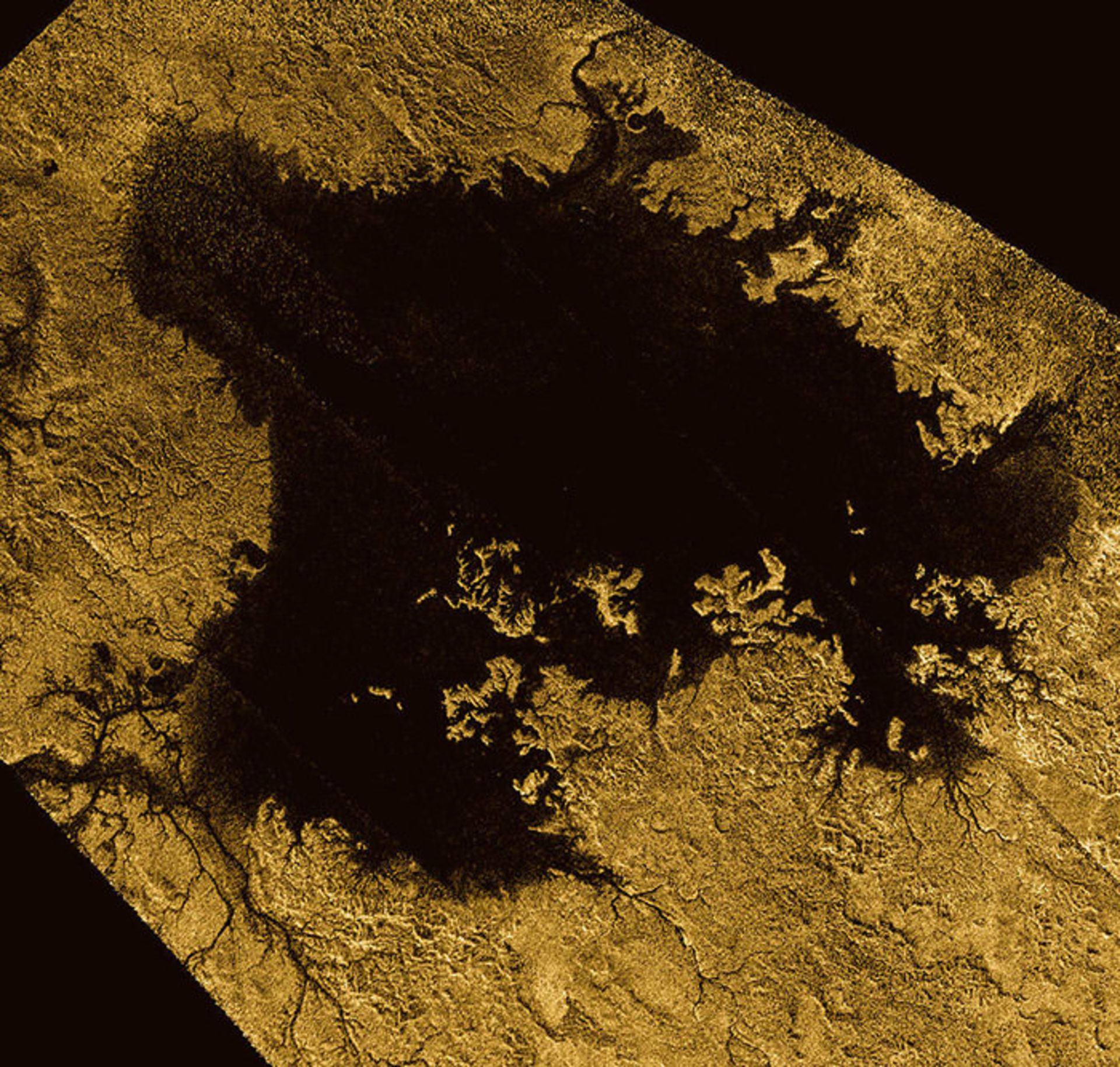
Cassini image of Titan’s north polar hydrocarbon lake
Scientists are not sure about the exact formation and origin of Titan. However, the atmosphere of this moon has clues. A number of Cassini Huygens probe instruments measured nitrogen-14 and nitrogen-15 isotopes in Titan’s atmosphere. According to the findings, the nitrogen isotope ratio found in Titan is very similar to the isotope of comets in the Everett cloud. The globular Oort cloud consists of hundreds of billions of icy bodies located between 5,000 and 100,000 AU from the Sun (each AU equals 150 million km). The nitrogen ratio of Titan’s atmosphere shows that the building blocks of this moon were formed in the same gas and dust cloud as the Sun in the early history of the solar system, and the origin of these blocks is not the hot disk of Saturn’s material.
Surface: Titan’s surface is one of the most similar to Earth in the entire solar system. Of course, its temperatures are lower and it has different chemical characteristics. The surface temperature of Titan reaches minus 179 degrees Celsius. Titan may also have volcanic activity. The surface of this moon is full of methane and ethane streams that form large river and lake channels. No other world in the entire solar system (except Earth) has surface liquid.
Titan’s rains are made of methane and form the moon’s seas and lakes
Atmosphere: Nearly 95% of Titan’s atmosphere is nitrogen and 5% is methane. Traces of carbon compounds can also be found in the atmosphere of this planet. At the heights of this moon, methane and nitrogen molecules are decomposed due to the impact of the ultraviolet light of the sun and energetic particles. Parts of this molecule are recombined and produce various biological chemicals such as materials containing carbon, hydrogen, nitrogen, oxygen, and other essential elements for life.
Some of the compounds are formed by decomposition and cycle of methane and nitrogen. Methane and nitrogen create a thick, orange cloud that covers the surface of this moon, which is why it is difficult to examine Titan’s surface from space. The origin of all the methane in the atmosphere still remains a mystery.

The presence of methane and nitrogen in Titan’s atmosphere causes orange clouds
The potential for life on Titan
Cassini’s numerous gravity measurements of Titan suggest that the moon has a subsurface ocean of liquid water, possibly mixed with salt and ammonia. The European Space Agency’s Huygens probe also measured radio signals from the moon’s surface in 2005, indicating oceans 55 to 80 kilometers below Titan’s icy surface. The discovery of a global ocean of liquid water also places Titan in the group of moons of the solar system that have the potential for life. In addition to these rivers, lakes, and seas of methane and liquid ethane on the surface of Titan, they could act as a habitable environment on the surface of this moon, although any possible life on this moon would be different from terrestrial life; Therefore, Titan can host habitats and suitable conditions for life, including life that we know (in the subsurface ocean) and life that we do not know (in surface hydrocarbon liquids). Although evidence of life on Titan’s surface has yet to be discovered, the moon’s complex and unique chemical nature are definitive findings that make it an ideal destination for exploration.
Enceladus
Few moons in the solar system are as fascinating as Enceladus. Some of these moons are thought to have oceans of liquid water beneath their frozen crusts, but one of the unique features of Enceladus is its glaciers. Based on samples obtained from space probes, Enceladus has the most chemical elements necessary for life and probably has hydrothermal or hydrothermal vents that transport hot mineral water from subsurface oceans.
About the size of Arizona, Enceladus has the whitest and most reflective surface in the Solar System. This moon has a ring system and releases ice fragments into its orbit in space. These fragments form Saturn’s E ring. The name Enceladus comes from Greek mythology. The images of the Voyager spacecraft in the 1980s show that this moon, despite its small size (approximately 500 km in diameter), has a relatively smooth ice surface in some places and has a high brightness. In fact, Enceladus is one of the most reflective bodies in the solar system, the reason for which scientists did not know for years.
Since Enceladus reflects a large part of the sunlight, its surface temperature is extremely low and reaches minus 201 degrees Celsius. Enceladus is located at a distance of 238 thousand kilometers from Saturn between the orbits of two other moons, Mimas and Tethys. The moon is tidally locked to Saturn, taking approximately 32.9 hours to complete one orbit in the densest part of Saturn’s E ring.
In 2005, NASA’s Cassini spacecraft revealed water ice, and gas particles ejected from the surface of Enceladus at speeds of approximately 400 meters per second. These eruptions appear to be continuous, creating a huge halo of icy dust around Enceladus that forms the material of Saturn’s E ring. Only a small fraction of this material enters the ring, and most of it falls on the surface of Enceladus as snow. For this reason, this moon has a white and bright surface.
Enceladus’ glaciers originate from relatively warm cracks in its crust, which scientists call tiger stripes. Several gases such as water vapor, carbon dioxide, methane, and maybe a little ammonia, carbon monoxide, and nitrogen along with salt and silica make up the gas cover of Enceladus’ glacial channels. The density of biological material in glaciers is twenty times higher than expected by scientists.
Based on measurements of the Doppler effect and the very small amplitude of Enceladus’ wobble as it spins around, scientists have discovered a global ocean beneath the moon’s surface. They believe that the thickness of the ice shell of Enceladus in its south pole is close to 1 to 5 km. The average thickness of the entire crust is between 20 and 25 km.
Since the ocean of Enceladus has ice, and the glaciers form Saturn’s E ring, examining the E ring could mean examining the ocean of Enceladus. A large part of the E ring is made up of ice particles, but among them you can also find very small particles of silica. These particles are formed when liquid water and rock react with each other at temperatures above 90 degrees Celsius. This is another indication of the existence of warm blue channels under the icy crust of Enceladus, which are not dissimilar to the warm blue channels of the Earth’s oceans. Enceladus is one of the prime candidates for life in the solar system with features such as a global ocean, unique chemistry and internal heat.
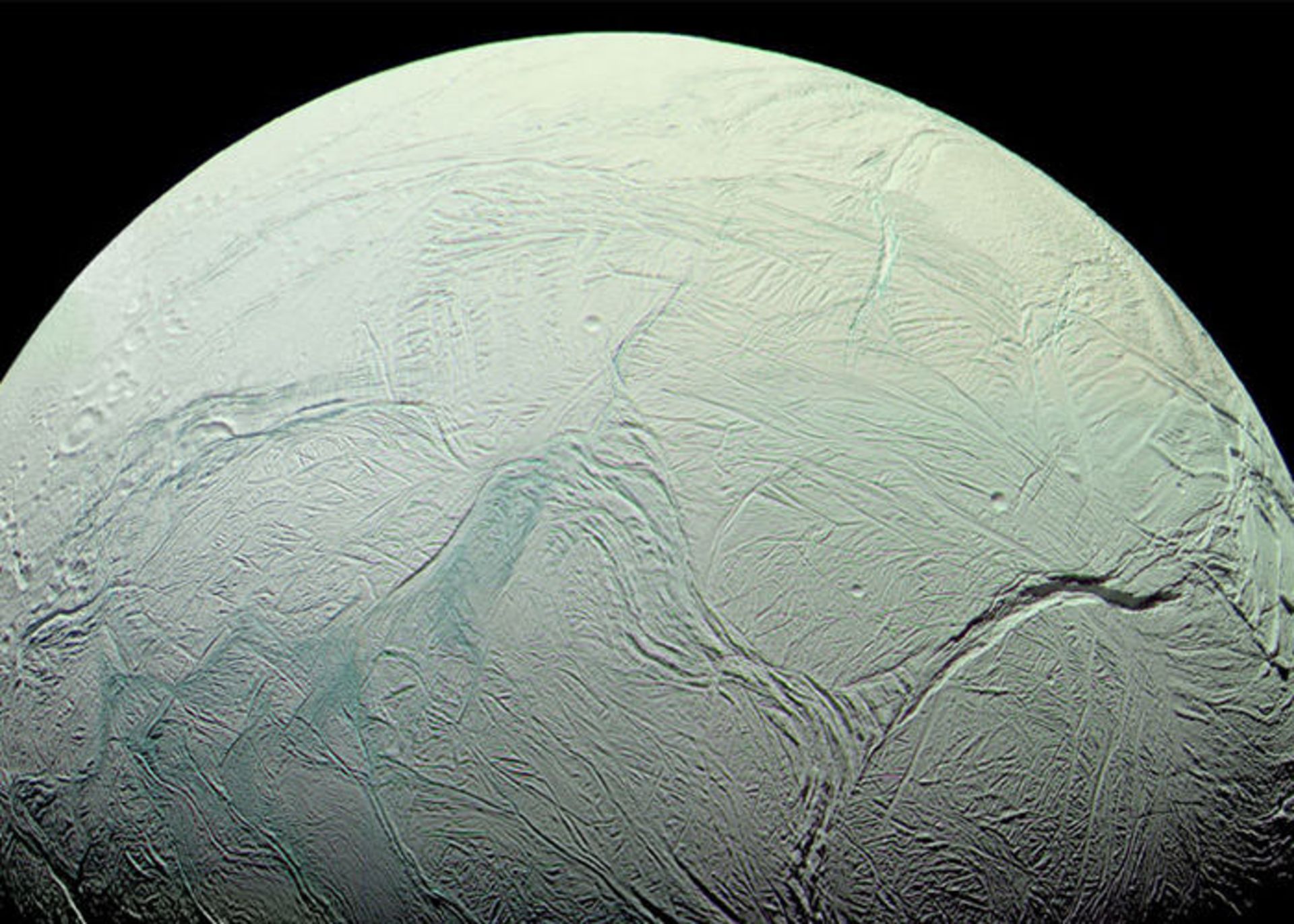
Iapetus
Iapetus is the third largest moon of Saturn and the eleventh largest moon in the entire solar system. The young Cassini discovered this moon on October 25, 1671. However, Iapetus was seen by astronomers as a point whose brightness changed during Saturn’s orbital period. Voyager 1 and 2 probes visited the Saturn system and this moon in the 1980s and revealed its strange features. The diameter of the Iapetus reaches 736 km. Like Rhea, three-fourths of Iapetus, the other moon of Saturn, is made of ice, and one-fourth of it is made of rock.
According to the two claims of Iapetus, Saturn’s moon is included in the list of strange moons of the solar system. This moon was discovered in 1671 and one side is dimmer than the other side. The part of the hemisphere facing Saturn’s orbit is dark brown in color; while the other hemisphere is light gray. According to a theory explaining the color difference of this moon, the side facing Saturn is covered with dust that was spread by small meteorite impacts on other small outer moons of Saturn.
Meanwhile, the Cassini images tell a more complicated story. Most of the dark material on the surface of Iapetus originates from inside this moon and leaves behind dark streaks by the sublimation of dusty ice from the moon’s surface (solid to vapor). This process probably begins with the accretion of dust from exoplanets.
Also, Iapetus has a mountain range 13 km high and 20 km wide at the equator, which gives it a distinctive walnut-like appearance. The origin of this mountain range is unknown. According to some theories, this mountain is a fossil from the time of the faster rotation of Iaptus, which arose in the equatorial part; While others believe that this mountain is the result of pebbles from the ancient ring system around this moon that collapsed and landed on the surface.

Hyperion
Hyperion is the largest non-spherical irregular moon of Saturn. Its average radius is 135 km, but since this moon is potato-shaped, its shape can be described based on its diameter along three axes. Hyperion has a strange appearance: its surface is like a sponge or coral with dark pits and sharp grooves formed by ice and lighter rocks. However, this is not the only strange feature of Hyperion: Hyperion was the first discovered non-spherical moon and has an eccentric orbit.
Hyperion’s rotation does not coincide with its orbital period and orbits Saturn in an irregular pattern; so that its rotation axis fluctuates unpredictably. Like other moons of the solar system, Hyperion is made of water ice; But its surface is strangely dark. According to Cassini spacecraft estimates, the density of Hyperion is 55% of that of water; As a result, a large part of its interior is empty.
According to a popular theory, one of the reasons for Hyperion’s strange properties is that it was a remnant of a larger moon that was probably located between Titan and Iapetus and was destroyed by a collision with a large comet. The remaining material condensed again and formed Hyperion.
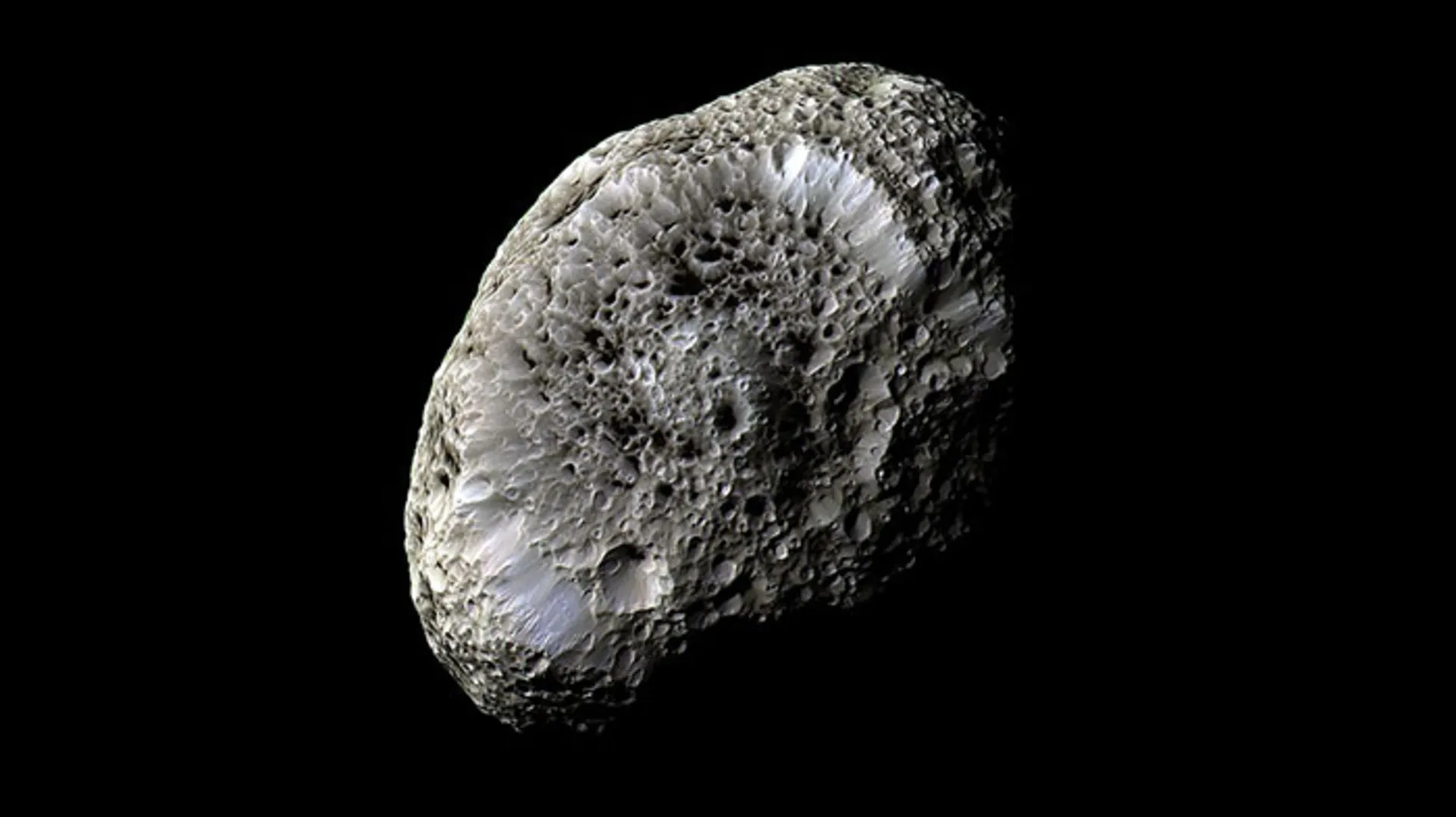
Mimas
The Voyager probes shocked scientists by capturing detailed images of Saturn’s moon Mimas in the 1980s. This moon is very similar to the Death Star in the sci-fi movie Star Wars. A large impact crater covers one of the hemispheres of this moon and is exactly the same size and similar to the destructive laser plate that George Lucas mentioned; But Mimas is more than just an element of popular culture.
Mimas is Saturn’s innermost moon, orbiting closer to Saturn than Enceladus and farther than Pan and Atlas. The diameter of this moon reaches 396 km; For this reason, the smallest object in the solar system is spherical in shape.
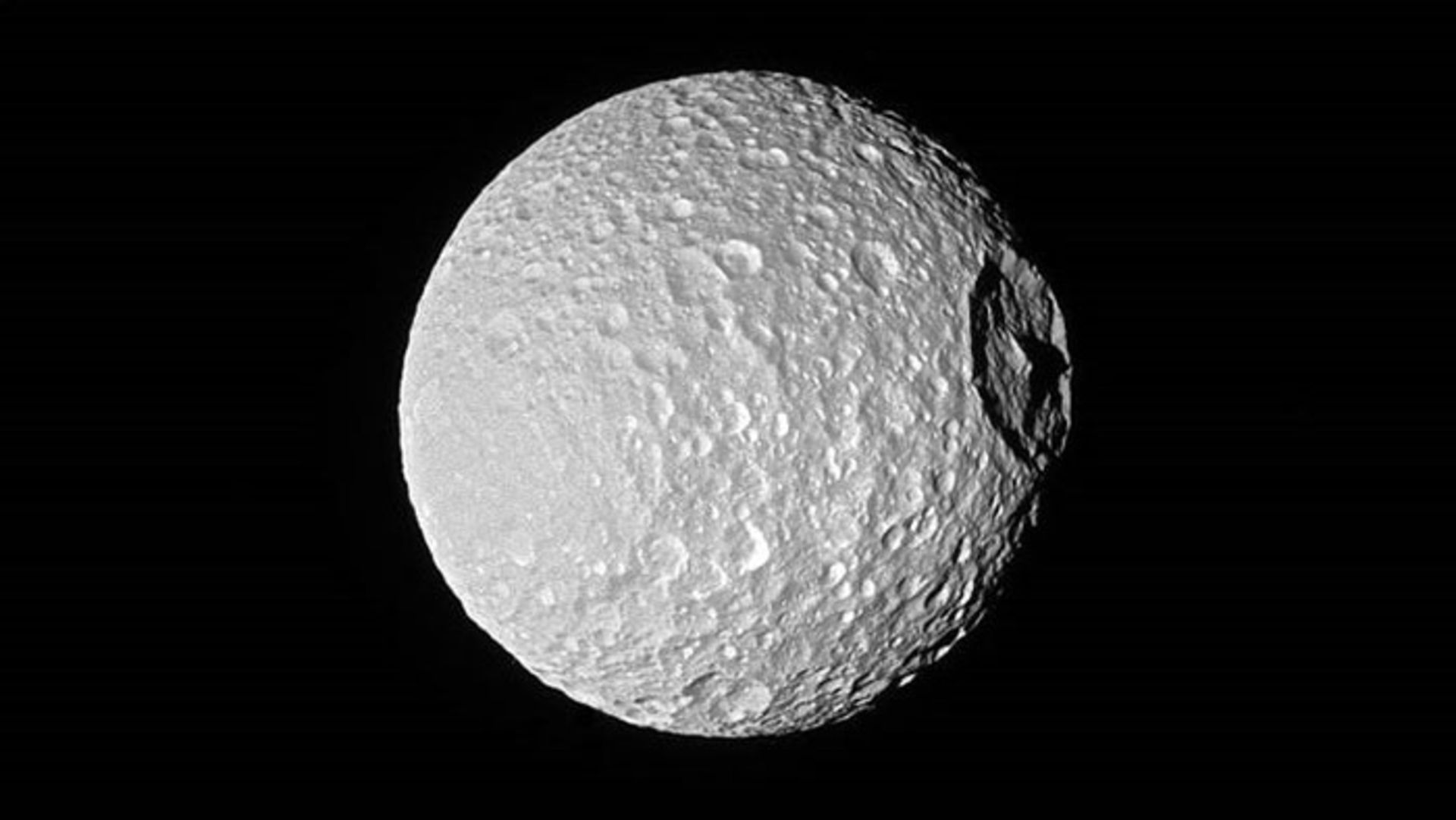
Herschel impact crater on the surface of Mimas. The name of this impact crater is derived from the name of William Herschel, who discovered this moon in 1789.
Pan and Atlas
Pan and Atlas are both Saturn’s innermost moons. Atlas orbits Saturn at the outer edge of the A ring. It takes approximately 14.4 hours for Atlas to complete one orbit of Saturn, and 8.13 hours for Pan. Saturn’s moons Pan and Atlas are the smallest moons in the solar system. Despite their small size, these moons can influence Saturn’s ring system. These small worlds are perhaps the best-known examples of shepherd moons. Shepherd moons are small moons that are located in the ring systems of giant planets. As their name suggests, these moons help particles in the Saturn system stick together, while also cleaning up other particles.
Pan causes Encke Gap; A prominent resolution is seen in the bright ring A; While Atlas is located outside the ring A. The most important feature of both moons is their smooth surface, which looks like a flying saucer or a walnut. Bonnie Borrati of NASA’s Jet Propulsion Experiment believes these moons are covered in tiny particles that clear the space between the rings.

Pan and Atlas in the shape of a flying saucer
Rhea
Rhea is the second largest moon of Saturn, but its average radius is one-third that of Titan, Saturn’s largest moon. Rhea is a small, cold and airless world that is very similar to its moons, Dione and Tethys. Like the other two moons, Rhea has a tidal lock to Saturn, which means that one side of it is always seen from Saturn. It takes 4.5 Earth days for Rhea to complete one orbit of Saturn. The surface temperature of Rhea is similar to that of Dion and Tethys, which reaches minus 174 degrees Celsius in sunny areas and minus 220 degrees Celsius in shadow areas. Rhea, like Dion and Tethys, has a high reflectivity and shows that its surface is mainly composed of water ice.
Rhea is located at a distance of 527,000 km from Saturn and is a bit further from Dione and Tethys. In 2010, the Cassini spacecraft discovered a very thin atmosphere called the exosphere around Rhea, which is a mixture of oxygen and carbon dioxide. Cassini also detected signs of material in Rhea’s orbit in 2008. This was the first discovery of a ring around a moon.
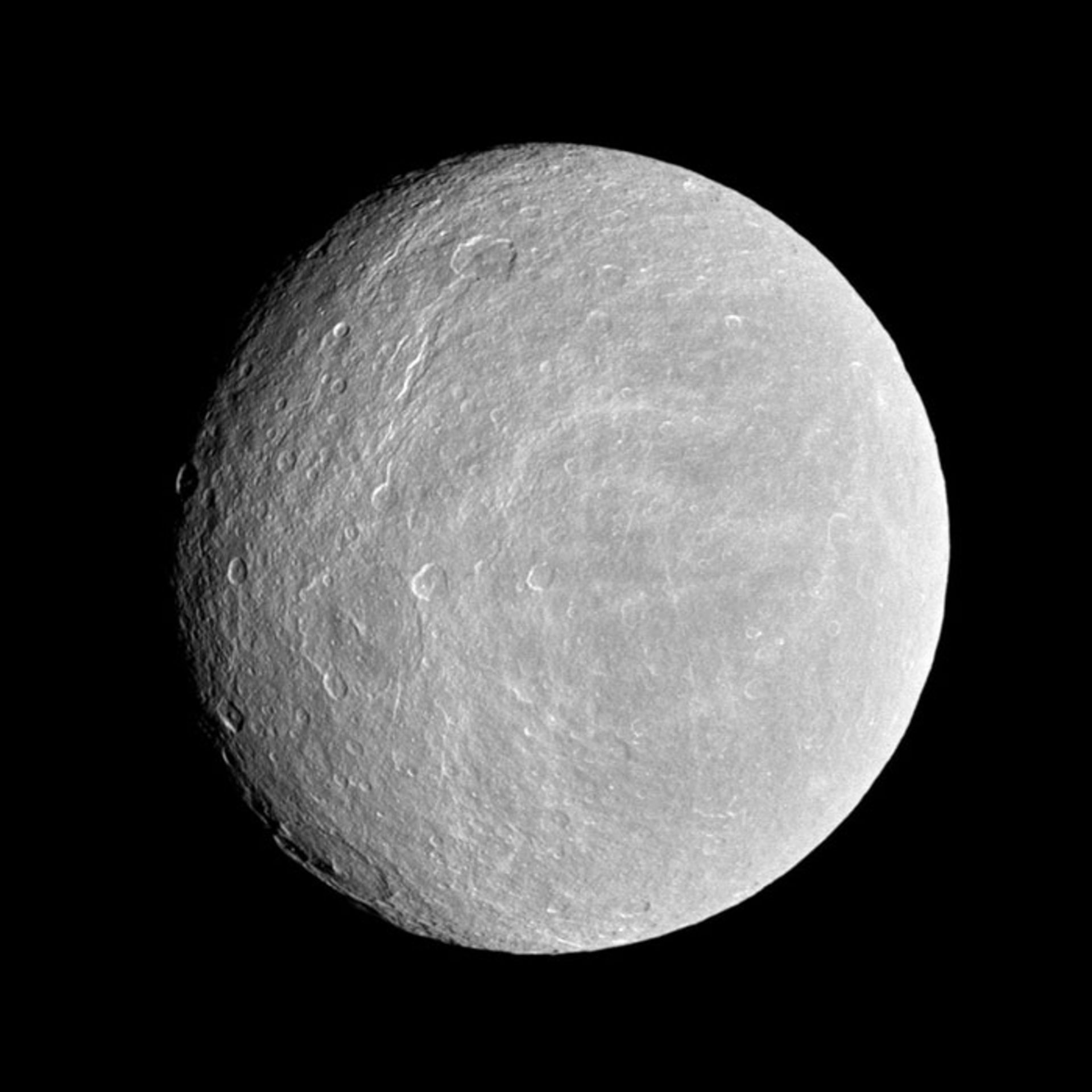
Dione is a small moon with an average radius of 562 km that completes the orbit of Saturn once every 2.7 days. This moon is located at a distance of 377 thousand kilometers from Saturn, which is exactly equal to the distance between the moon and the Earth. The density of dione is 1.48 times that of liquid water, as a result, one-third of dione is made up of a dense core (probably of silicate rock), and the rest is made of ice.
Very fine icy powders (similar to smoke) from Saturn’s E ring bombard the surface of Dione. The E ring dust is formed from the icy moon Enceladus. The surface of Dion is full of impact craters so that the diameter of the craters reaches 100 km.
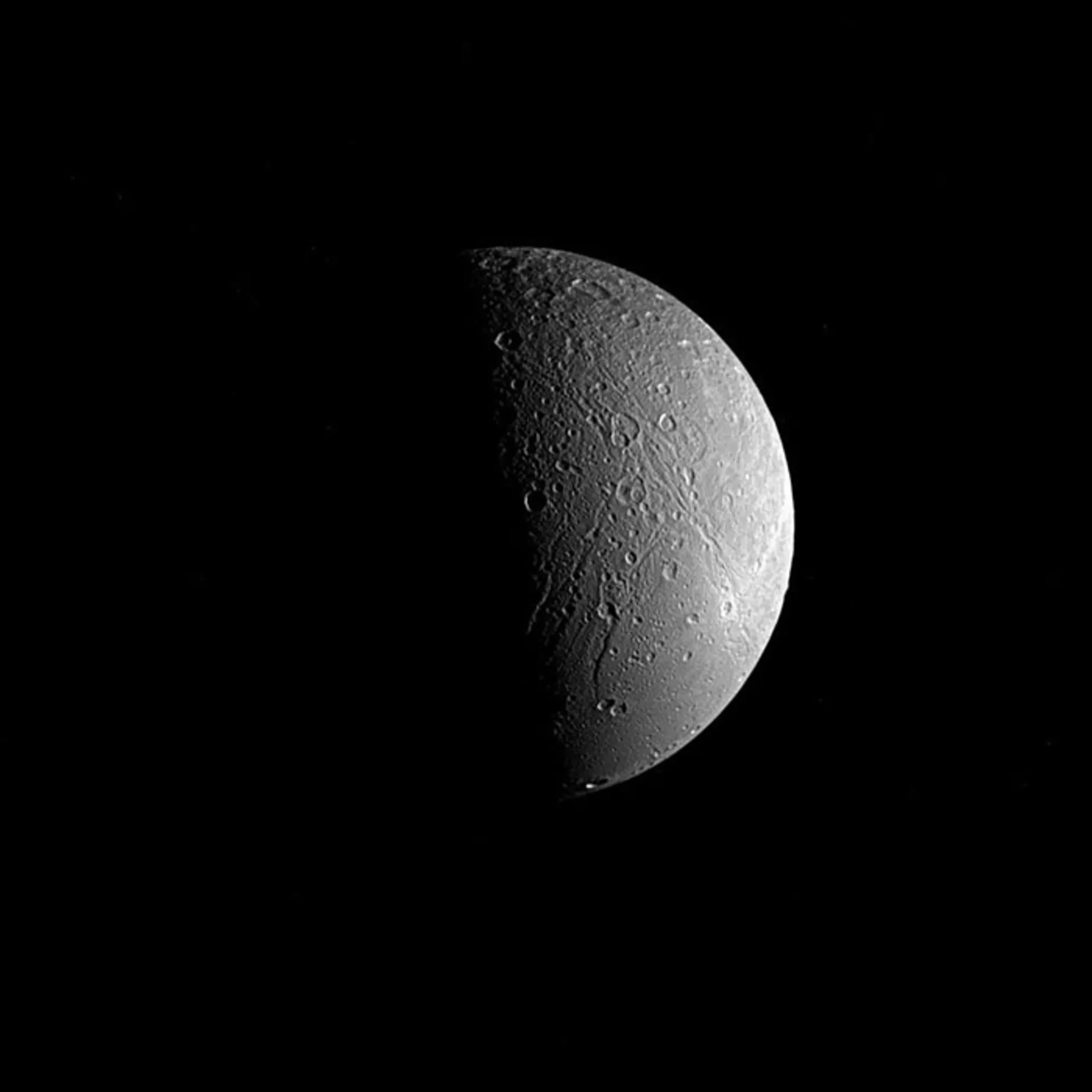
Tethys
Tethys is the fifth largest moon of Saturn. Its average radius reaches 633 km. This cold and airless moon is very similar to its sister moons, Dione and Rhea. Of course, with the exception that Tethys does not have many impact craters like the other two moons. A large part of Tethys is made up of water ice and a small part of it is made up of rock.
Tethys has a high reflectivity and this feature is another indication of its ice composition. The average temperature of Tethys reaches minus 187 degrees Celsius. Tethys appears as a small dot in the night sky, and its true nature was revealed after a visit by the Voyager probes. It takes 3.45 hours for Tethys to complete the orbit of Saturn.

The wonders of the planet Saturn
Hexagonal Storm: Saturn’s north pole has a fascinating feature called a hexagonal wind flow. This hexagonal pattern was first observed from images sent by the Voyager spacecraft and then observed from a closer distance by Cassini. This hexagon, whose diameter reaches 30,000 km, is a wavy current, whose wind speed reaches 322 km/h, and a storm is placed in its center. This storm is unique in the entire solar system. At the south pole of Saturn, there is also evidence of storm currents, but no hexagonal waves are seen. According to NASA reports from Cassini in November 2006, a tornado-like storm was observed at Saturn’s south pole.
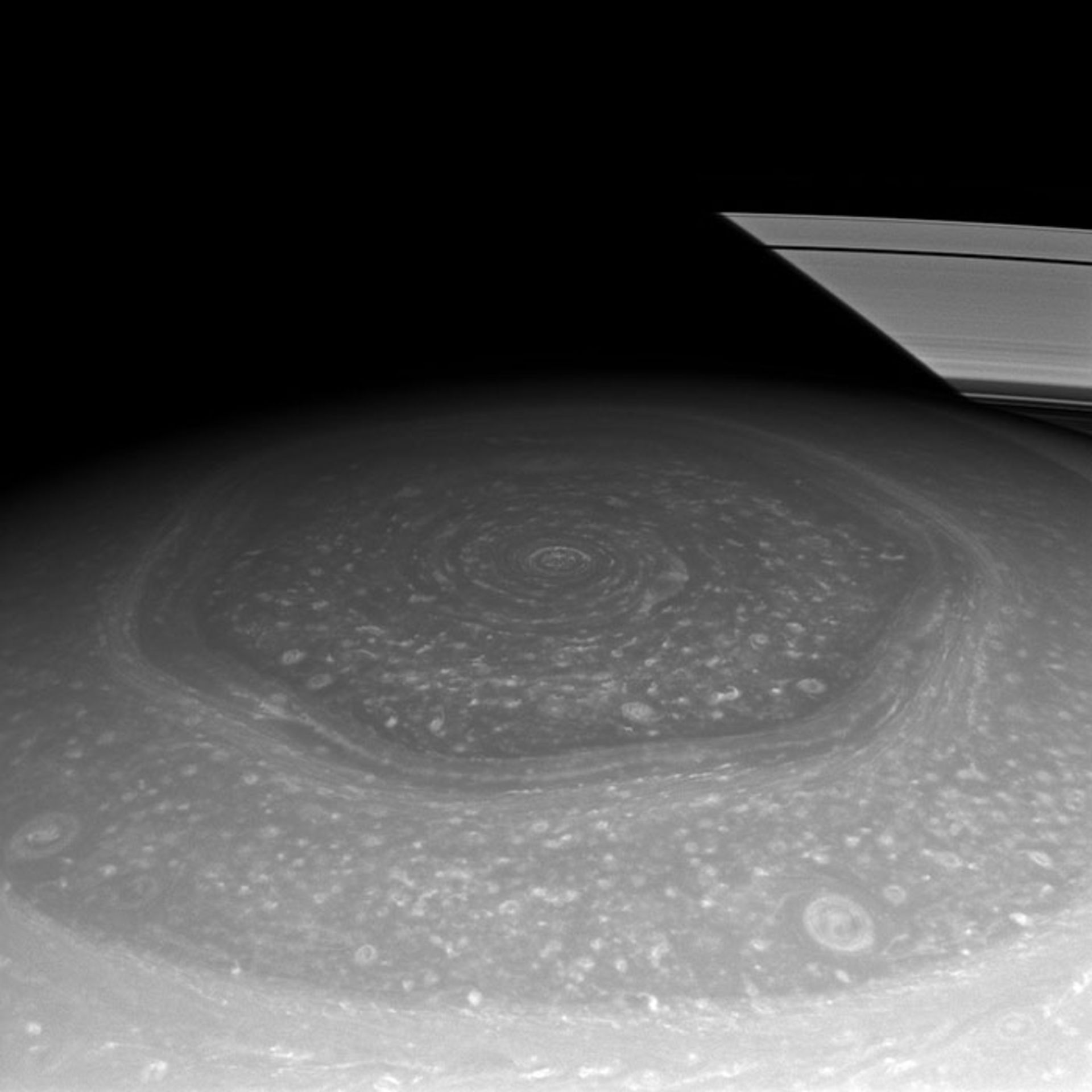
Reduction of rings: According to NASA research, Saturn’s rings have been decreasing at a maximum speed since Voyager probes visited this planet. These rings were attracted towards this planet due to gravity and under the influence of Saturn’s magnetic field. According to scientists, Saturn’s rings will be completely destroyed in three hundred million years, on the other hand, according to Cassini’s findings, Saturn’s rings are relatively young and their life is less than one hundred million years. As a result, the rings of Saturn are much younger compared to the life of this planet (4 billion years).
Long seasons: Saturn has seasonal changes like Earth, but Saturn’s seasons have a major difference from Earth’s seasons. It takes one year for the Earth to complete the orbit of the sun, during this time the Earth experiences cold and hot seasons. But since Saturn is far from the Sun, it takes 29 Earth years to complete the orbit of the Sun. As a result, one Saturn year is equal to 29 Earth years. Therefore, the seasons also get longer and the duration of each Saturnian season is approximately seven years.
Diamond rain: Since the internal structure of Saturn is completely different from the structure of Earth, its rains are not made of water but of diamonds. According to scientists, ten million tons of diamonds are produced in Saturn’s atmosphere every year. This phenomenon occurs thanks to the combination of methane gas (CH4) with the wind activities of this planet. Saturn’s rays have a high temperature and are 10,000 times stronger than Earth’s rays, and when they are emitted, they break molecular bonds and separate hydrogen and carbon.
Ten million tons of diamond rain falls on Saturn every year
The carbon atoms join together to form larger molecules that result in a soot-like compound. This black cloud is far from a diamond, but the story does not end there. The new molecule is relatively heavy and will fall down when caught in the planet’s gravity trap. By falling to greater depths, the temperature and pressure on the molecules also increase. These conditions lead to carbon transformation. At first, carbon is converted to graphite. The same stuff that’s inside your pencils and then turns into one-centimeter-diameter diamonds and they keep falling.
Seeing Saturn from Earth
The observation and exploration of Saturn can be divided into three phases. The first period of ancient observations (including observations with the naked eye) is before the invention of the telescope. Advanced ground-based telescopic observations began in the 17th century. According to written history, the planet Saturn has been one of the main elements of many myths. Babylonian astronomers systematically observed and recorded the movements of Saturn.
The third phase was the visit of space probes, simultaneously with this period of ground-based observations (including the Hubble Space Telescope) continued. To see Saturn’s rings, you need a telescope with a diameter of at least 15 mm. Christian Huygens was able to achieve this success in 1659. Before that, Galileo had observed Saturn with his early telescope and thought that Saturn was not completely spherical. Until Huygens was able to observe Saturn’s rings for the first time with a more advanced telescope. Huygens also discovered Titan, Saturn’s largest moon. Later, the young Domenico Cassini discovered four more moons of Saturn: Iapetus, Rhea, Tethys, and Dione.
William Herschel discovered two other moons, Mimas and Enceladus, in 1789. A British team also discovered Hyperion in 1848. William Henry Pickering discovered Phoebe in 1899, which is an irregular moon that does not rotate perfectly in sync with Saturn and its other moons. In the 20th century, studies of Titan proved the existence of a thick atmosphere on this moon.
Discoveries of Saturn in the Space Age
In the modern era, Hubble Space Telescope observations continued. Pioneer 11 was the first spacecraft to observe Saturn from a close distance, later Voyager 1 and 2 provided more detailed observations. But Cassini was the only orbiter that provided more detailed and comprehensive information about Saturn, and the Huygens probe of this spacecraft landed on the surface of Titan for the first time in 2005.
Pioneer discoveries 11
Pioneer 11 passed through the upper clouds of Saturn for the first time in September 1979. Pioneer 11 photographed Saturn and several of its moons, although the quality of the images is low and does not show much detail. The spacecraft also examined Saturn’s rings and revealed the thin F ring.
Pioneer 11 also showed that dark gaps in Saturn’s rings appear bright and contain light-scattering material when viewed from a high phase angle (towards the Sun). Another achievement of Pioneer in the exploration of Saturn was to measure the temperature of Titan.
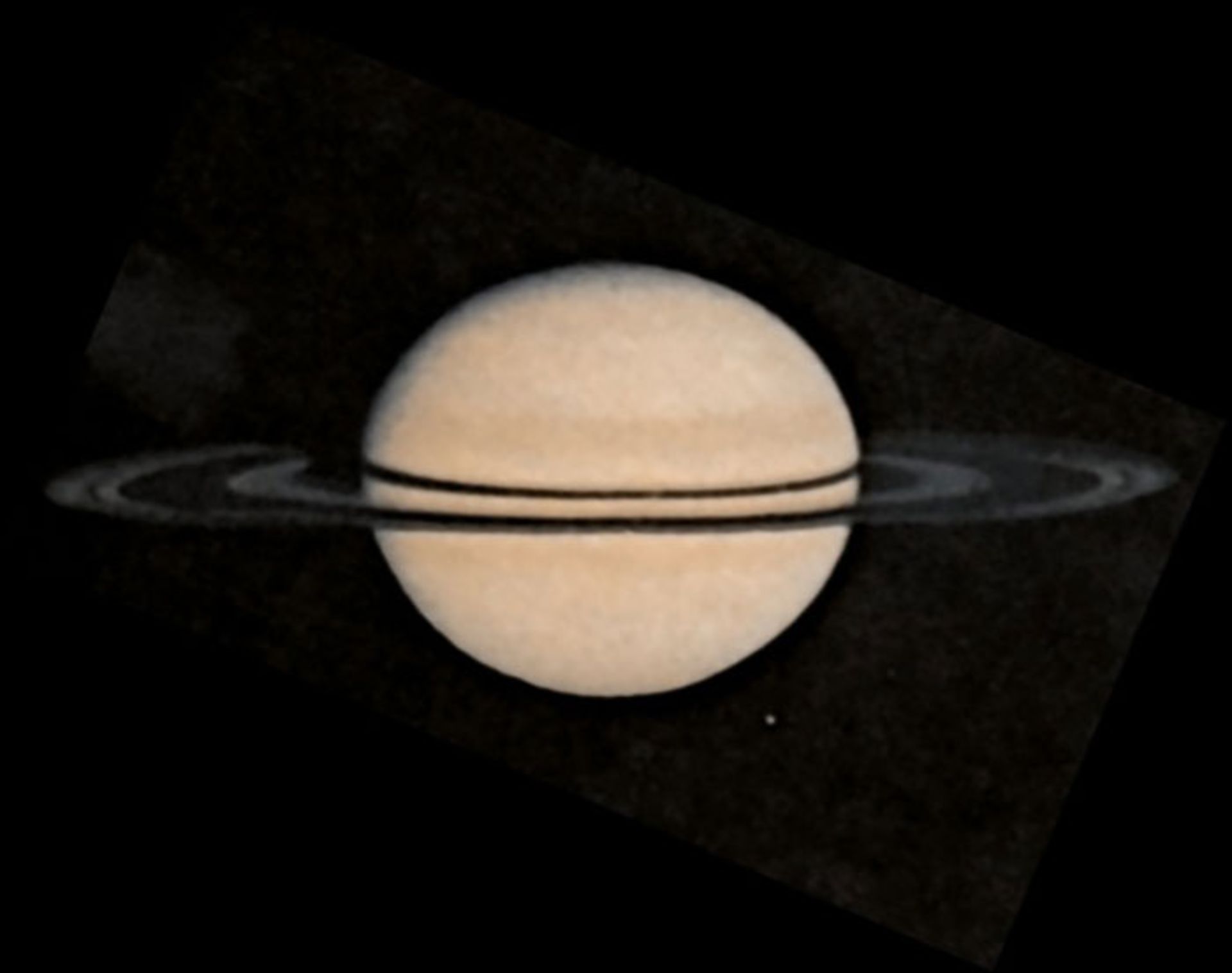
Pioneer 11 low quality image of Saturn
Voyager 1 and 2 discoveries
Voyager 1 visited the Saturn system in November 1980. The probe released the first high-quality images of the planet, its rings, and its moons. The surface features of Saturn’s moons were first revealed by Voyager. Voyager 1 approached the moon Titan and sent back a lot of information about the moon’s atmosphere. According to the data of this probe, Titan’s atmosphere is impenetrable in visible wavelengths, as a result, none of its surface details were seen.
Almost a year later, in August 1981, Voyager 2 continued its survey of the Saturn system. More detailed images of Saturn’s moons were sent, as well as evidence of atmospheric changes and its rings. Unfortunately, the probe’s rotatable camera malfunctioned for several days during the Saturn survey, and many views were not recorded. Operators used Saturn’s gravity to redirect the spacecraft toward Uranus. The two Voyager probes discovered a number of moons near and inside Saturn’s rings, as well as the small Maxwell fissure (a gap in the C ring) and the Keeler fissure (a wide, 42 km gap in the A ring).
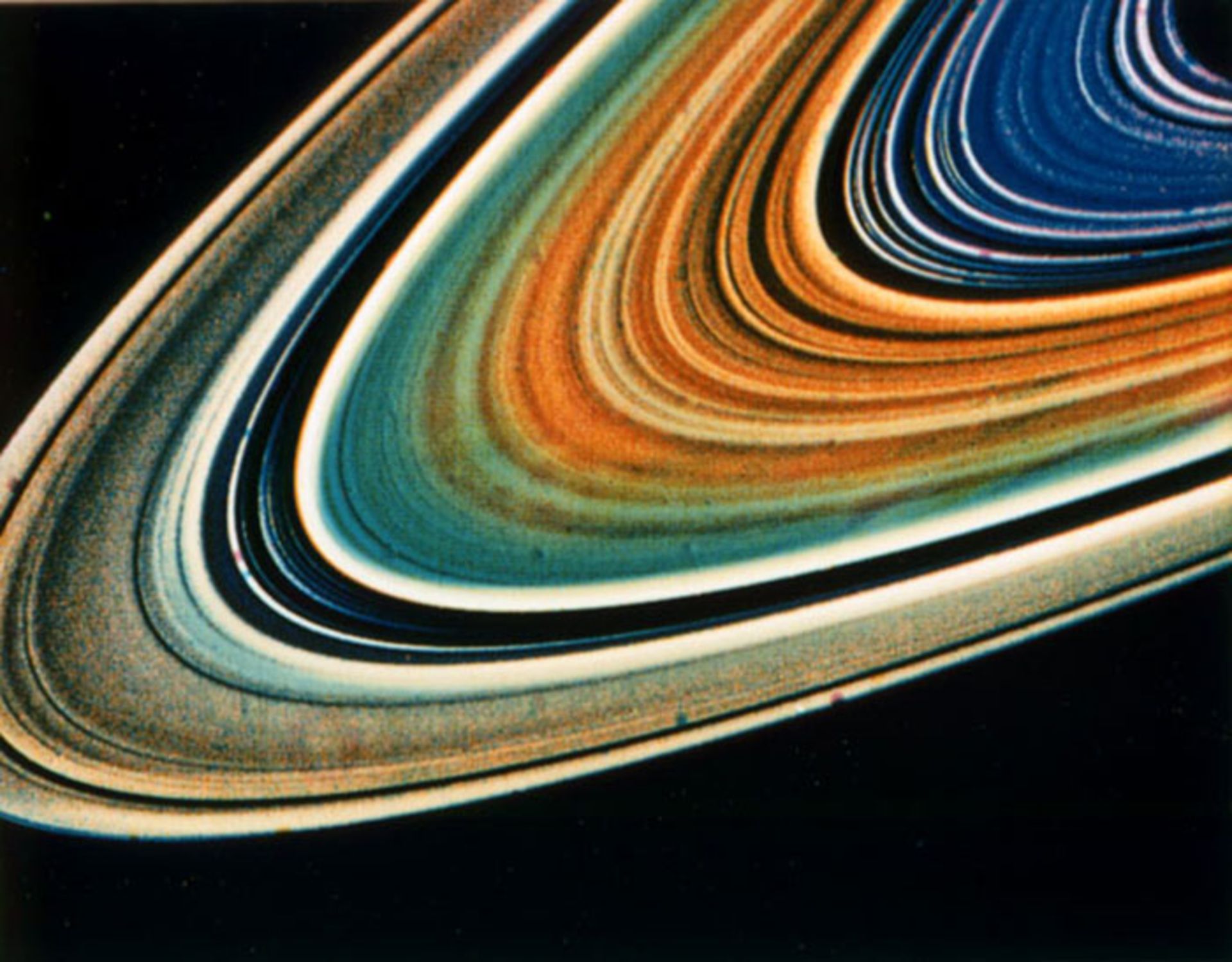
Image captured by Voyager 2
Cassini Huygens: Exploring the Saturn System
The Cassini spacecraft began orbiting Saturn on June 30, 2004 and continued its mission until September 15, 2017, when the probe ended its life by hitting the planet’s atmosphere. The destruction of Cassini was intentional and to ensure that the moons Enceladus and Titan were not contaminated. Cassini’s achievements include the discovery of the glaciers of Enceladus and the discovery of new moons for Saturn. Cassini was a joint project of multiple space agencies and was pitted against NASA’s older and larger probes, including Pioneer and Voyager. Cassini’s partners were NASA, the European Space Agency, and the Italian Space Agency.
Cassini was the first spacecraft dedicated entirely to studying Saturn and its ring system. The orbiter was named after Giovanni Cassini, an astronomer of the 17th century. Cassini was not launched directly at Saturn. Rather, its mission was a little more complicated. Before reaching Saturn, he checked the planets Venus (twice), Earth, and Jupiter and thus used the gravity of each planet to increase his speed. This 5700 kg spacecraft was launched on October 15, 1997. It reached Venus in April 1998, Earth in August 1999, and Jupiter in December 2000.
Cassini finally entered Saturn’s orbit on July 1, 2004. One of the main goals of this mission was to discover more moons for Saturn and to discover the structure and color of the rings, as well as to get more information about the moons of this planet. Cassini carried a passenger called the Huygens probe. Huygens landed on the surface of Titan on January 14, 2005, and transmitted data to Earth for 2.5 hours.
In this short period of time, the researchers obtained images of the surface as well as information about the gases and winds in the atmosphere and on the surface of Titan. Cassini discovered two new moons for Saturn and discovered the presence of liquid water on the surface of Enceladus and its glaciers. It also published more details about Titan’s methane lake. Other Cassini discoveries include the following:
- Debris 80 km from the surface of Iapetus
- A close-up view of the Rhea moon and its impact craters.
- The discovery of a large ring approximately 12 million kilometers from Saturn, which is probably composed of particles from the moon Phoebe.
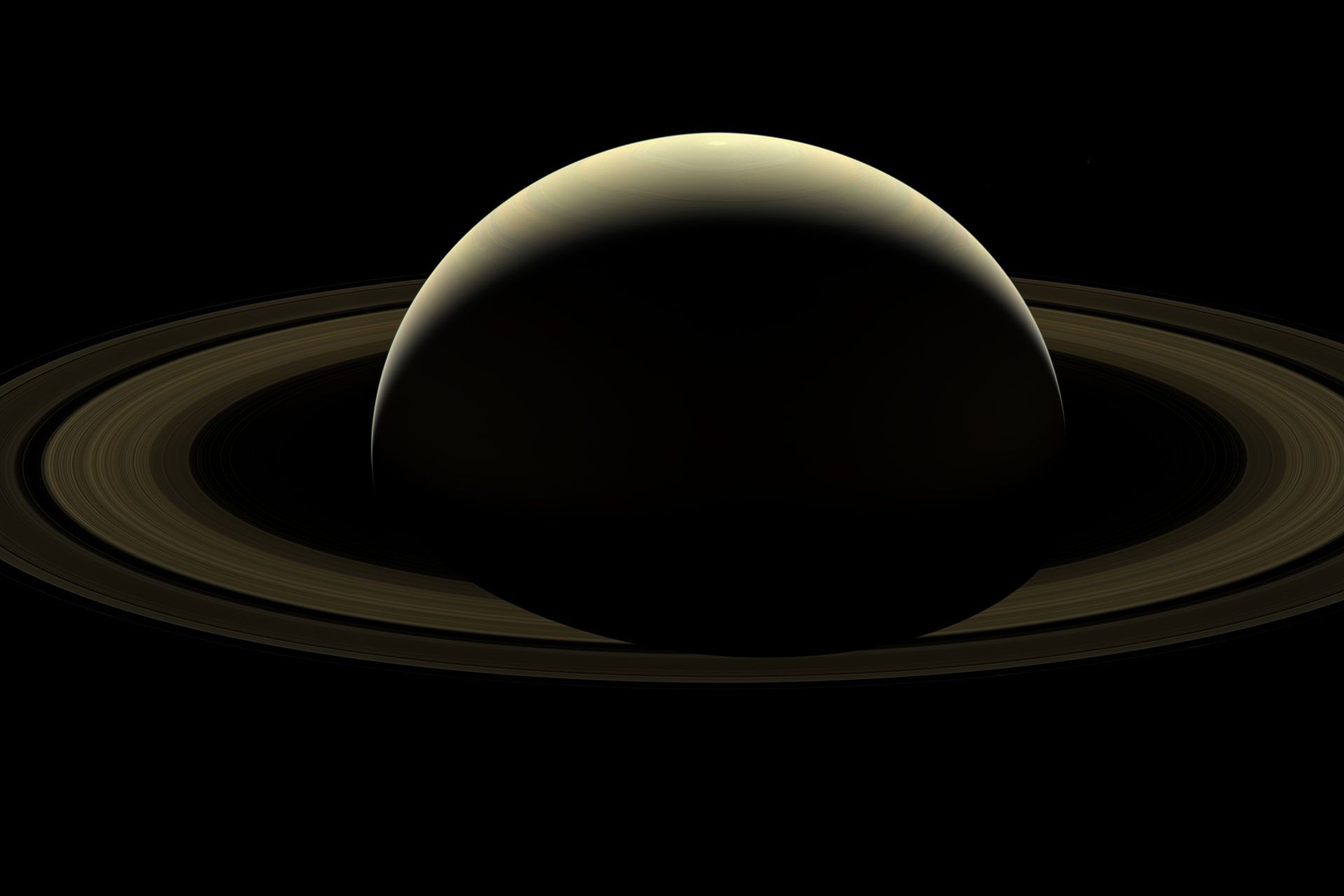
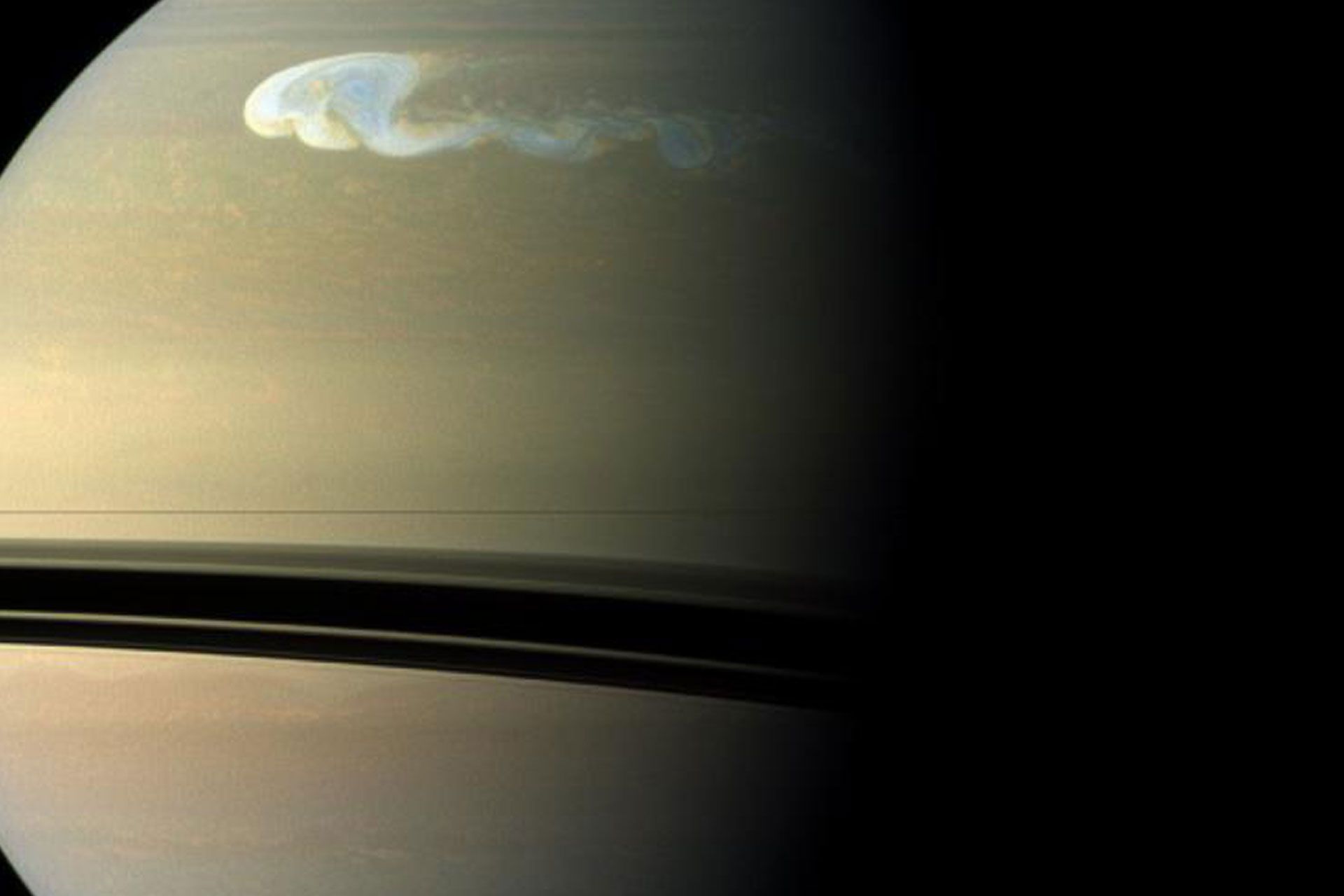

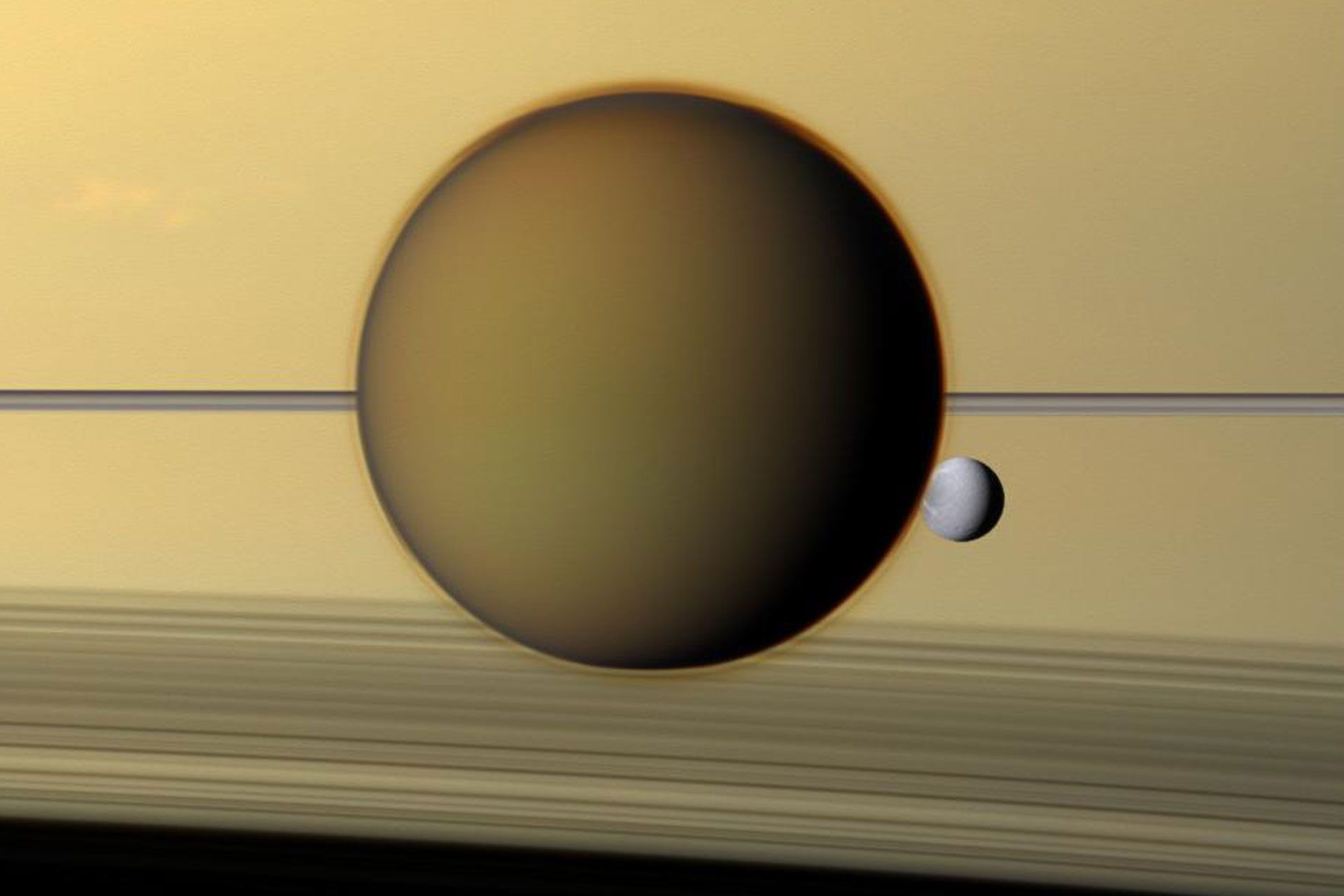
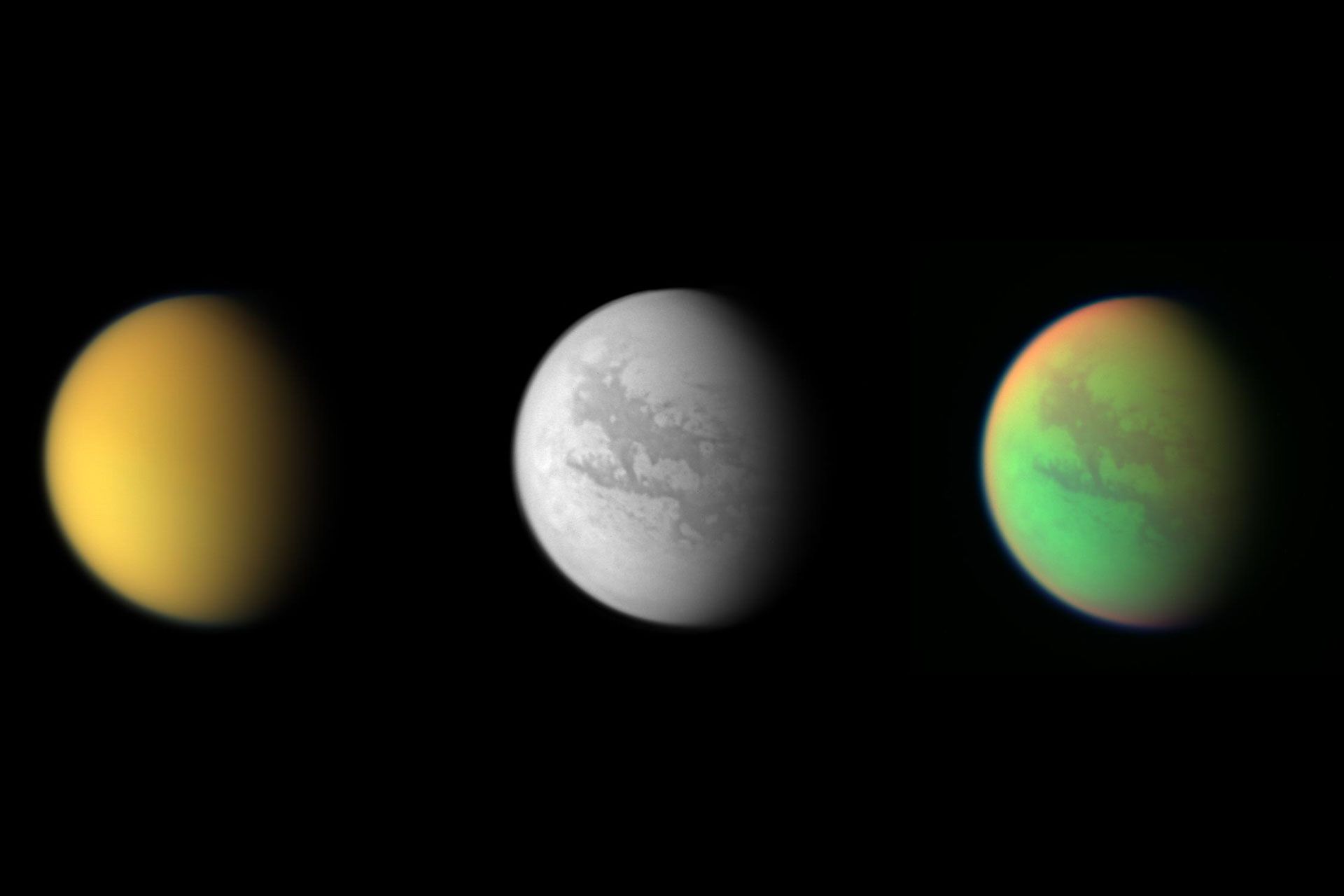
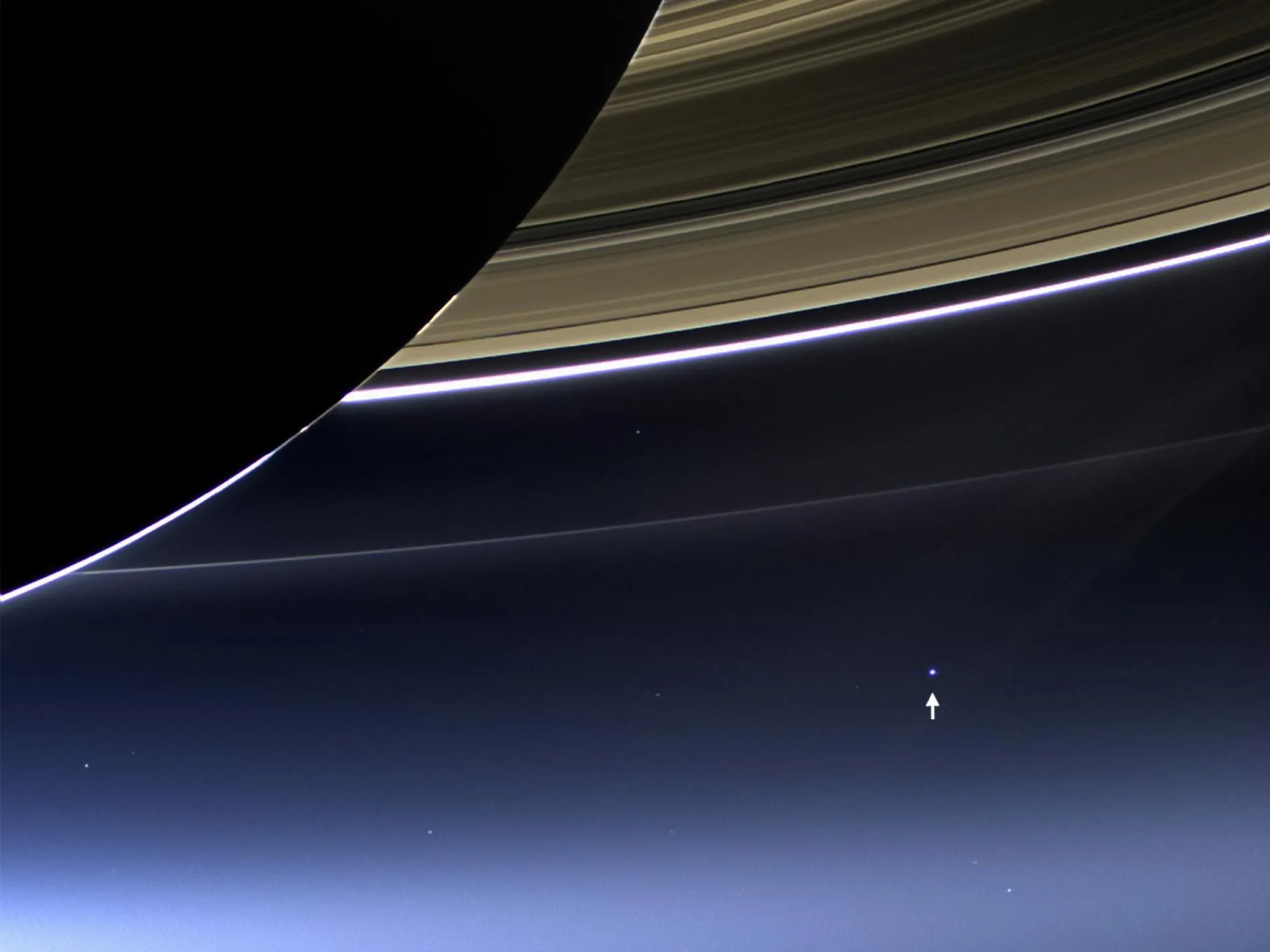
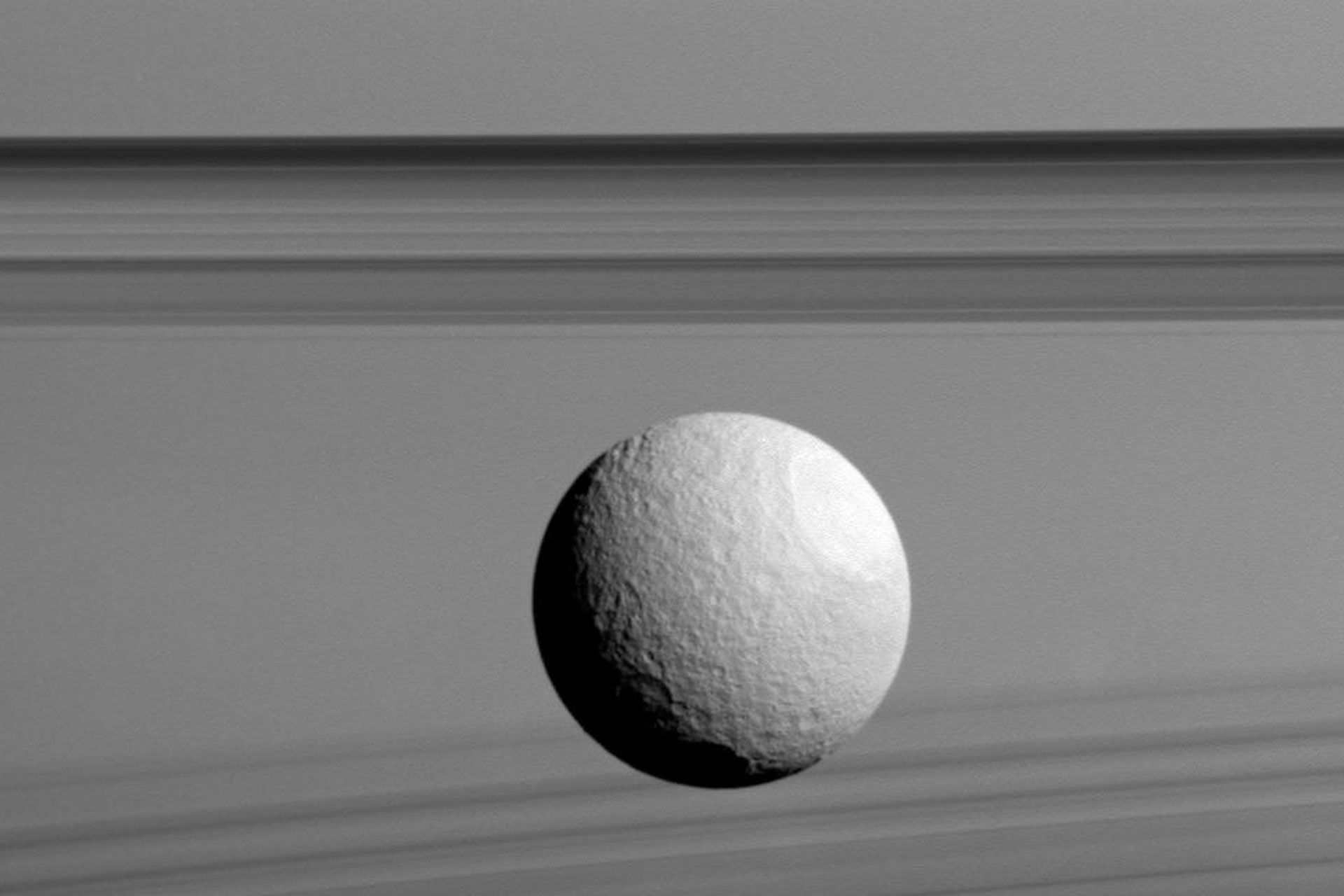

A selection of images captured by the Cassini Huygens spacecraft
Farewell to Cassini
Cassini’s last data was transmitted to Earth on September 15, 2017; Then this probe was destroyed by collision with Saturn’s atmosphere. This was Cassini’s last orbit around Saturn after 13 years of exploration and investigation. According to NASA experts, Cassini disintegrated 45 seconds after its last transmission due to the heat and friction of the fall.
Shortly after Cassini broke up, its mission planner Eric Sturm outlined his plan to report on his and his team’s experiences on the mission. The mission is over, but its scientific results will be published for decades to come because the entire data has not yet been analyzed.
Future missions to Saturn
Among the proposed plans for explorations on the planet Saturn, the robotic probe Dragonfly has reached the approval stage of NASA. The probe is in the form of a drone and will investigate hundreds of locations on Titan, Saturn’s moon. It will also sample and measure the composition of biological materials on the surface of Titan and search for life on this moon. Dragonfly will launch in 2026 and reach Saturn in 2034.


You may like
-

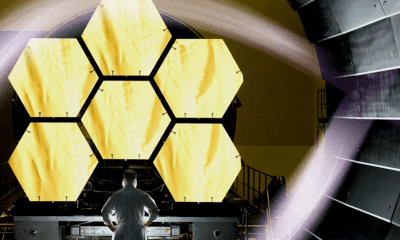


The James Webb Space Telescope; A look at the vastness of the universe
-

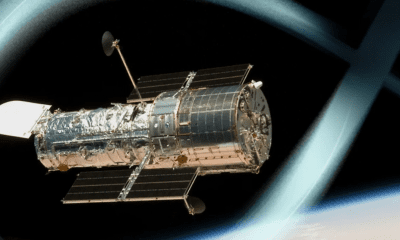


Hubble Space Telescope; A portal to the mysterious depths of the universe
-




Moons of Jupiter; Features and Explorations
-

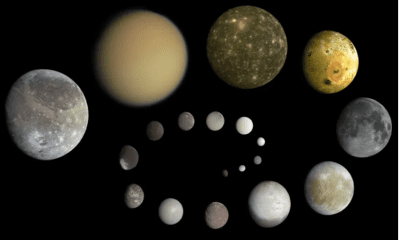


Ten strange moons of the solar system
-

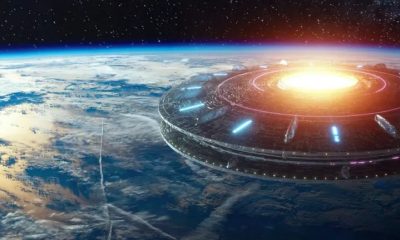


Extraterrestrial civilizations may be too advanced to detect
-

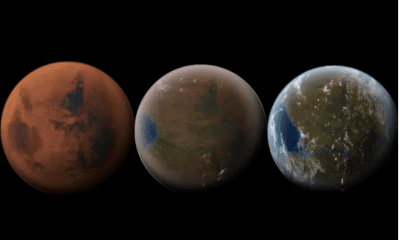


Landing Mars may be easier than scientists think


Conjunction: Expressing a condition.
Conjunction: Connecting two to create a new well-formed formula that requires it to only be true when both of the two formulas are true.
Noun: In rhythm, the second half of a divided beat.
Noun: breath.
Noun: ; steam fog.
Verb: To breathe; whisper; devise; imagine.
The Icon of the Seas cruise ship, a city on water
On January 27, 2024, the first passengers of Icon of the Seas stepped on the deck of the world’s largest ship to experience an enchanting discovery in the west and east of the Caribbean Sea; A journey for eight days and seven nights.
The cruise tourism industry set a new record in 2023 with an increase of 2 million passengers over four years; But the biggest news on the high seas in 2024 was the maiden voyage of the world’s largest cruise ship, three times the length of a football field and five times the size of the Titanic.
Icon of the Seas ship with 20 decks and gross weight of 250,800 tons and a capacity of 9,950 people is the most amazing human-made phenomenon that goes to unknown waters like a luxurious metropolis. The 2,805 bedrooms in 28 groups, including family cabins with infinity-view balconies and bunk beds, offer a relaxing feel to adventurers looking for unique accommodations during their travels.
The Icon of the Seas is three times the length of a football field and five times the size of the Titanic
The symbol of the seas, the newest member of the Royal Caribbean cruise family, has dethroned its previous generation counterpart, the Wonder of the Seas, as the world’s largest ship, but beyond its gigantic and astonishing dimensions, this ship has also broken other records and claims various It is “the first” and “the most”.
The unveiling of Icon of the Seas sparked a wave of surprise, excitement, and curiosity among Internet users. The images that were published during the first voyage of the ship, followed endless discussions, comments, and questions of the interested people on social networks. Let’s take a look at some fascinating and stunning facts about this maritime marvel:
Icon of the Seas key features at a glance
- The largest ship in the world with a length of 365 meters, a width of 67 meters, and a weight of 250 thousand tons
- It has the largest and most optimal interior space with more than 20 decks
- It has advanced technical equipment and luxurious cabins for 7514 passengers and 2350 crew members
- The most compatible with the environment and the least carbon emissions with LNG engines
- Using artificial intelligence for optimal energy consumption on board
- The highest cost of building a cruise ship with about 2 billion euros
- It has more than 20 restaurants with international menus
- Extensive recreational facilities such as a floating bar, rock climbing walls, large slides, and infinity pools.
Also, in December 2023, Lionel Messi’s name was registered as the sponsor and “godfather” of Icon of the Seas.

The beginning of the story
In 1996, the architects of two companies, Royal Caribbean (Royal Caribbean) and Wilson Butler (Wilson Butler) defined a new mission for themselves: “Providing an environment for the best family vacations on the planet.” Over the past 28 years, these two companies have launched 24 giant cruise ships, each of which was recognized as the world’s leading floating artifact of its time.
In the mid-2010s, the cruise industry was growing rapidly and major cruise lines were looking to create different experiences and more innovations to attract passengers. In this regard, in 2016, Royal Caribbean proposed a new idea, the implementation of which challenges the innovation boundaries of the entire industry:
“Launching a project to build a new cruise ship that will be unique not only in terms of size but also in terms of technology, amenities, and environmental sustainability.”
Builders and designers
To implement its plan, Royal Caribbean Group prioritized several main goals:
First, the optimal use of ship space to build multiple sections with different uses that at the same time work in an integrated and coordinated manner. The second priority of the builders was to significantly reduce the harmful effects on the environment, and for this purpose, the use of green technologies, energy consumption optimization systems, and reduction of carbon emissions were considered in all stages of design.
In addition, in order to provide a unique experience, the new ship had to meet all the needs of passengers, including recreation, relaxation, and adventure; Therefore, the companies had to design each area as a multi-purpose, modern, and intelligent space.
Therefore, the Finnish company Meyer Turku, one of the largest and most reliable shipbuilders in the world, was chosen as the main contractor for the construction and design of the ship’s structure and hull. This company, which had previously collaborated with Royal Caribbean in the construction of two Oasis-class ships and had a lot of experience in the construction of cruise ships, was responsible for the design of the hull, mechanical systems, and structural integrity of the ship.
The Swedish company Tillberg Design of Sweden, as the second partner of the project, is committed to creating a unique and inspiring space by using the latest techniques and production materials. Tilburg Design had to focus on the priority that the interior of the ship should not only be luxurious and luxurious, but also efficient and innovative.
Finally, Royal Caribbean’s oldest partner, the American company Wilson Butler, which is famous for designing public and cultural spaces, entered the project as the third partner with the aim of creating a space that evokes the feeling of a city floating on water for passengers. In addition to these partners, during the construction of the ship according to the needs of each department, other teams from different countries of the world were invited to cooperate.
Scott Butler, director and founder of the Wilson Butler Company in 2023, said about the design of this ship:
The design of a ship is not much different from the design of a building on land. Our work is like designing a building that is in a constant state of vibration. In fact, the great design of a ship proceeds just like the planning of a city.
What makes Icon of the Seas look like a city on the water are the “neighborhoods” or planned areas named Aquadome, Thrill Island, Chill Island, Surfside, Hideway, and Central Park, which we will take a look at in the following sections.
Ship building
The construction of Icon of the Seas officially started in early 2019. The first stage, as is usual in the construction of any large ship, involved checking the details and carrying out preliminary tests.
At this stage, the designers carefully focused on the body shape, propulsion, and energy systems, as well as environmental sustainability. Advanced fluid dynamics (CFD) simulations were also performed to ensure high efficiency and reduced hull drag in water.
In October 2019, Mir Company inaugurated the project, according to the common tradition of shipbuilders, by cutting the steel sheets used in the ship’s hull.
Azipod propulsion systems and LNG fuel
The Icon ship’s six engines were provided by the Finnish company Wärtsilä with a dual propulsion system to use heavy oil and liquefied natural gas (LNG) as fuel.
The LNG propulsion system produces much less nitrogen oxide than traditional fuels, which is a big step towards cleaner seas. Accordingly, two 307-meter tanks with a capacity of 27 tons were transferred to the ship for LNG fuel.
The ship’s fuel system was equipped with “high pressure tanks” and “heat exchangers”, which allowed the storage and optimal use of LNG. Also, this system was connected to the combustion management unit, which continuously adjusts the fuel quality and combustion efficiency, and prevents the creation of harmful NOx gases by precisely controlling the fuel-air mixture.
LNG fuel tanks being transferred to the ship
Royal Caribbean
The Icon of the Seas propulsion system was designed based on azipods, which are among the most advanced electric propulsion technologies in the marine industry. Unlike conventional propulsion systems where a fixed propeller is driven by a shaft, the Azipod enables the propeller to rotate 360 degrees.
Azipods increase the maneuverability of the ship
This complete rotation capability increases the ship’s maneuverability reduces the need for lateral propulsion systems such as rudders, and particularly facilitates the stopping or moving of the ship in narrow harbors. Also, the design of azipods is such that it minimizes the turbulence created in the water, and by reducing water resistance, it reduces fuel consumption by 20% compared to conventional systems.
The deployment of three 20MW Azipod drives on the Icon ship increased the speed of this modern cruise to 22 knots (41 km/h).
Engineering-wise, azipods operate using induction motors and are powered by diesel generators or a combination of diesel and natural gas. These engines have high efficiency due to not having many moving parts and reducing friction, and on the other hand, using an efficient cooling system in Azipods increases their lifespan.
Two 307-meter LNG fuel tanks with a capacity of 27 tons provide the ship’s propulsion energy
Artificial intelligence not only recognizes the paths that require the least energy but also controls the energy consumption of numerous internal equipment such as air conditioning and elevator systems.
The lighting department of the ship was entrusted to Helamarine company, which creates a safe and pleasant atmosphere in the open seas with 20,000 low-consumption LEDs. At the same time, several complex and extensive optical systems provide accurate control of the light in the public areas of the ship digitally to the ship’s officials.
Intelligent ship control
Ship control includes an integrated management system (Integrated Bridge System) that is driven by advanced software and modern user interfaces. This system provides real-time monitoring and control of all operational parameters of the ship, including positioning, speed, route, and fuel consumption.
In addition, the IBS system is equipped with multiple sensors and warning systems that detect sudden changes in environmental or operational conditions and notify the crew.
The IBS system controls all operational parameters of the ship with multiple sensors
Using artificial intelligence and predictive algorithms, the intelligent control system can suggest the best sea routes and optimize fuel consumption. Also, the stabilization system (Stabilization System), which works in coordination with IBS, reduces the ship’s oscillating movements in turbulent sea conditions, which results in more passenger comfort and reduced depreciation of the ship’s structure.
Executive stages of ship construction
 Part of the Icon of the Seas construction process
Part of the Icon of the Seas construction process
The process of building the Icon of the Seas went through three complex but coordinated stages:
Design and simulation: The first stage included the initial design and computer simulation of the systems. Using specialized software and Computational Fluid Dynamics (CFD) simulators, accurate models of propulsion and fuel systems were prepared. These models were tested under different operational conditions to identify any possible defects or challenges before starting the actual development of different sectors and areas.
Construction and assembly of parts: In this stage, different parts of the ship were made in a modular way in special workshops. Then these parts were moved to the main ship building site and installed using super heavy cranes. To avoid any mistakes, the assembly process was done using automatic welding robots and laser measurement systems.
 Aquadome dome assembly stage
Aquadome dome assembly stage
Testing and commissioning: After the completion of the assembly, the ship was subjected to detailed tests. All sections were examined and adjusted separately and in combination with each other. At this stage, navigational tests including maneuverability tests, fuel efficiency, and response of control systems to variable conditions were conducted. These measures were accompanied by the simulation of different sea scenarios to prepare the ship to face any conditions.
Different parts of the ship are made modularly in special workshops and then transferred to the hull of the ship.
During the coronavirus pandemic, when the raw materials for construction were not available, the design personnel simulated, tested, and calibrated their designers in 3D by making replicas of different parts of the ship in appropriate sizes.
 Testing the Aquadome waterfall in the workshop
Testing the Aquadome waterfall in the workshop
Even the cabins were assembled in sections called “mega-blocks,” or modules, at the manufacturing plant, then at the docks, and then transferred to the ship. This reduced the build time and was like building a giant Lego.
Commitment to environmental technologies
As part of Royal Caribbean Group’s SEA the Future program, the company’s new ships are equipped with MAP and MAG systems that synthesize solid waste into gas and reuse it to generate energy.
These technologies not only minimize waste but also produce valuable by-products such as biochar, which can be used as a soil conditioner. According to the recycling programs of this ship, 90% of the waste is never buried in the soil. The energy obtained from the MAP system is also used in the ship itself.
MAP and MAG systems convert solid waste into gas
Another noteworthy point is that Royal Caribbean plans to reduce the food waste of this ship by 50% by 2025. In this futuristic plan, artificial intelligence is used for immediate food production according to existing needs and requests, and training of the ship’s crew with sustainable solutions is also on the agenda. The above program has led to the saving of 24% of food waste to date.
In another environmental innovation, the heat from the engine houses is used to desalinate seawater. 93% of the ship’s fresh water is produced and purified by the reverse osmosis system in the ship itself. Also, by producing small bubbles that cover the whole body of the ship, the compressors reduce the friction between the water and the body and subsequently reduce fuel consumption.
93% of the ship’s freshwater is purified and produced by a reverse osmosis system in the ship itself Mockler, Chief Decarbonisation Manager for the new build, describes Icon as a great example of how sustainability is being considered for the future:
What we did on board Icon was the beginning of a path, not an end goal. We want to use these ships as platforms to advance the development of technologies that we will need in future products; Because our effort is to draw the next modern ships in the most stable state possible.
Different departments and quarters of the ship
Icon of the Seas is described as a city on water because it consists of different neighborhoods; Including Hideway, Gobd Cascade, and Central Park, and we will have a close look at these amazing neighborhoods.
The Pearl: The pearl of the ship’s entrance

The Pearl section was designed and introduced by one of Brooklyn’s media artists. This spherical piece with a diameter of 15.3 meters is covered with more than 3,600,000 moving computer tiles and is now known as the largest kinetic art sculpture in the world, which displays an unprecedented fusion of art and technology.
This awe-inspiring work stands out not only for its grandeur, but also for its depiction of the essence of the ocean, as it beautifully simulates various natural phenomena such as rolling waves, gentle breezes, meteors, and a dynamic ocean surface. Inspired by the sea, the tiles are arranged in a Fibonacci sequence and reflect the patterns found in marine life.
The movements of “Marwaid” are influenced by the tide and wind data of the Caribbean Sea. This data, obtained from the web or the ship’s sensors, allows the massive pearl to constantly change and reflect the current environmental conditions in an ever-evolving display.
More than 3,600,000 computer-animated tiles inspired by marine life patterns are arranged in a Fibonacci sequence.
The Pearl area, like the entire ship, is an architectural masterpiece and a prime example of the innovative use of modern technology in the cruise industry. This spherical pearl is spread over four decks of the ship and welcomes passengers as a gateway as soon as they board. In the center of the pearl, a beautiful marble staircase connects the floors.
The Pearl derives its spherical form from a steel ball that acts as a supporting structure. Prominent engineers have also planned and deployed the infrastructure technologies of this sector: a combination of more than 5 thousand controllable LED lights and interactive media technology creates stunning visual effects and adapts to the environment at every moment.
The moving tiles, produced with Linear technology, create computer-controlled lighting effects. Also, the integrated sound system of more than a thousand watts enriches the listening experience of passengers and elevates their mood to higher levels. The total structural load of this section is estimated to be around 20 tons.
The iconic pearl is not just an eye-catcher but serves as a central point of reference for passengers exploring the heart of the ship.
AquaDome waterfall dome; Manifestation of art and technology

Located at the front of the ship, the Aquadome has a huge space with a magnificent glass dome that offers viewers a wide and captivating view of the ocean. This area has the “highest waterfall” in the middle of the sea along with other exciting attractions. The construction of this dome set the record for the largest glass and steel structure installed on a ship.
AquaDome; The highest waterfall in the middle of the sea with a height of 16.7 meters
Of course, the waterfall itself with a height of 16.7 meters attracts attention as one of the engineering miracles of shape change. The Aquadome transforms throughout the day, offering passengers a variety of delightful experiences, from breathtaking sunrises to vibrant daytime activities. During the day, travelers can tour the AquaDome Market, eat at its restaurant, or sit and watch the 220-degree view of the surrounding ocean.
As evening approaches and sunset approaches, the waterfall becomes a dynamic backdrop for a diverse range of entertaining shows that take place nightly. In this way, the Aquadome creates a dramatic scene beyond a tall waterfall, with energetic movements and captivating lighting, which enhances the quality of every show beyond imagination. The show center of this neighborhood is called AquaTheater.




Michael Bailey, CEO of Royal Caribbean International, says about the construction of this section:
We went through an amazing journey with the engineers, architects and designers to build the AquaDome, and what amazes travelers is a testament to the innovation and creativity of the teams.
Aquadom neighborhood with an area of more than 33 thousand square meters extends from deck 14 to deck 22. The beautiful dome was built outside the ship so that other teams could complete the forward deck at the same time. The sea dome weighing 367 tons consists of 12 different modules with 673 glass panels and 712 aluminum panels and it took 8 months to assemble them.
The first marine dome with 673 glass panels and 712 aluminum panels
The process of lifting and connecting the dome to the spreader was done with 54 cables, and when the crane wanted to place it in a special position on the ship, another 12 cables were added. Just maneuvering it into place using a specialized rig took 80 hours. During this time, a separate team monitored the weather conditions to find the safest time to depart.
Central Park: Green Paradise in the heart of the sea

Central Parks are usually one of the most popular parts of Royal Caribbean cruises: a green and playful atmosphere that evokes the experience of being immersed in a park, and even the sound of birdsong. The presence of bars, cafes, restaurants, and shops in these areas makes them a pleasant environment to work.
But the Icon ship has also improved the class of Central Park in a surprising way: the central park with an area of several thousand square meters contains more than 33 thousand natural plants of different species that grow well with intelligent irrigation and lighting systems.
The largest cruise ship park with more than 33 thousand natural plants
To manage water in this section, a multi-layer drainage system was created under the ground surface. This system collects excess water and returns it to the smart irrigation system. In addition, the plants that were planted in this neighborhood were selected based on their resistance to sea conditions, including strong winds and direct sunlight, and each plant was carefully placed in a suitable place according to the light and irrigation needs.
This neighborhood also uses the fresh sea air to create a cool and comfortable environment by using advanced ventilation techniques. Smart lighting systems have been developed in a way that preserves the sense of naturalness of the environment even at night.
Royal Promenade: The beating heart of the ship

Royal Promenade is a busy and exciting street located in the center of the ship and is considered a place for gathering, shopping, and entertainment for passengers. This neighborhood, with a large area spread over two floors, is considered one of the most important and busiest parts of the ship.
From clothing boutiques to electronics stores, travelers can find almost anything they want in the department stores on this street. In addition to restaurants that offer a variety of international cuisines, the daily performance of live shows, music, and dance also doubles the vitality of the Royal Promenade.




The roof of this neighborhood is designed as a large digital screen that displays the sky views and attractive images, and the glass elevators also provide the opportunity to see all the surrounding scenery while moving passengers.
Surfside: a space for families

The space that was known as the Boardwalk in the Oasis class ships is designed in a unique and more advanced way in the Icon ship.
The most diverse entertainment facilities with smart security systems
For example, a large water playground is installed for children, and facilities such as splash pads, smaller water slides, Ferris wheel, face painting, arcades, sports areas, video game halls, and even a DJ play a significant role in entertaining families.
Separate restaurants and bars also make it possible for parents to grab something to eat or drink while the children are playing nearby while keeping an eye on their children. Easy access to Playmakers and an ice rink makes this neighborhood ideal for families.




From another angle, smart security systems guarantee the safety of all children in all parts of this neighborhood. Interactive applications also enable parents to manage their children’s entertainment programs online.
Chill Island: an ocean of tranquility

Chill Island is a neighborhood where travelers can get away from the daily hustle and relax in a calm and pleasant atmosphere. This neighborhood with artificial beaches and beautiful swimming pools provides the best atmosphere for travelers to relax and unwind.
It has the largest pool in the middle of the sea
In this three-story neighborhood, which occupies a good part of the middle of the ship, there are beaches with soft sand and comfortable chairs for relaxing, swimming pools with a curved design and jacuzzis with a view of the sea, and beach bars with a variety of cool drinks for passengers.
Some of the pools in this area are:
- Royal Bay: The largest pool in the middle of the sea, designed for all ages and located on the 15th deck.
- Cove Pool: A pool that is designed to face the ocean, and for this reason, it is also called an infinity pool.
- Cloud 17: Another pool overlooking the ocean with swirling water and a personalized and customized beverage bar that stands out on Deck 17.
- Swim & Tonic: The first water bar brand, a shallow pool with in-water seats that allow passengers to sit or stand comfortably and order their favorite drink. This pool is located on the 16th deck.



The water in the pools is purified and heated using modern technologies. Also, the surround sound systems reproduce the sound of waves and nature realistically so that passengers have the feeling of being on a real island.
The Hideaway: a modern and dynamic space for young people
Hideaway was originally designed with the aim of creating an attractive and modern space for young people and couples, and with a combination of fun and trendy facilities, it provides a great opportunity for travelers to spend their free time in a friendly and pleasant environment.
The floating pool can be considered one of the most prominent features of The Hideaway, which is located on the edge of the ship and offers a wonderful view of the sea. Several social spaces with live music and professional DJs provide revelers with lively nights, not unlike Texas clubs.
Smart lighting systems create subtle changes in the spectrum of colors and light intensity according to the event and time, and the advanced surround sound systems also bring a unique music experience to passengers.




In addition, if young people need to relax after several hours of fun, they can separate themselves from the surrounding noise in the exclusive lounges that have a very stylish and modern design, with comfortable chairs and light.
The interesting point is that Hideaway has spaces with multiple uses that can be changed quickly. For example, a lounge can be transformed from a daytime lounge to a nightclub.
Thrill Island Amusement Park: Innovation in Exciting Structures

A neighborhood located on the back deck of the ship, with a series of challenging games and activities for lovers of excitement and adventure. For example:
- The six water slides, which are the tallest marine specimens in the world, leave a unique memory and experience of free fall and speed in the minds of travelers.
- Adventure park with rope climbing routes, suspension bridges, and towers to climb
- Surfing simulator miniature golf and all kinds of energizing entertainment, each of which has its own fans.
It has the tallest water slides in the world and a surfing simulator
The construction of Thrill Island required advanced design and engineering to provide the desired facilities in a safe and efficient manner. For this purpose, in the structure of the water slides and adventure park, light, resistant, and stainless alloys were used, which can withstand high pressure and weight and have a long life.
One of the other requirements for the success of this neighborhood was intelligent safety monitoring and control systems that continuously monitor the condition of structures, equipment, and even weather conditions and take preventive measures if needed. For example, in case of sudden changes in wind speed, the FlowRider surf simulator automatically changes its settings to keep passengers safe.




On the other hand, due to the high volume of Thrill Island activities, special energy management systems were designed for this neighborhood. These systems help reduce overall energy consumption on board while maintaining an exciting experience for passengers.
District 6 in this neighborhood has a free fall slide called Pressure Drop, which falls from a height of 33 meters at an angle of 66 degrees.
 Crown’s Edge in Thrill Island
Crown’s Edge in Thrill Island
The most daring passengers can also go to the ship’s edge and make their way along the skyway that extends beyond the ship’s perimeter towards the open sea: Crown’s Edge, a suspended walkway 47 meters above the ocean, is a first-of-its-kind attraction. It is installed in the icon ship and has no similar example in the marine technologies of the world.
Absolute Zero: The Show on the Ice Arena

This area is considered to be the largest ice skating rink on ships in history, completely redesigned for bigger feats to amaze all passengers.
Passengers can sit on the seats around the square to watch star actors and artists perform high takeoffs and spectacular turns on skates. During the day, fans can enter the ice rink themselves and perform.
Suite Neighborhood: luxury accommodation
With special facilities and private space, the Suite Quarter offers the highest level of comfort and VIP services to passengers who have booked the ship’s luxury suites. Private lounge, modern design and stunning views, exclusive restaurants and bars, swimming pool and Jacuzzi, and private sun deck are just some of the facilities reserved for VIP passengers.
Each suite uses soundproof walls and is equipped with smart systems that allow travelers to manage the temperature, lighting, music, and even their orders in a personalized way.
In addition, passengers in this neighborhood have priority and faster access to all parts of the ship. The spacious deck area with plenty of seating in this two-story neighborhood provides a quiet and well-equipped area for families to relax.
Cabins
Although Icon of the Seas has fewer cabins (2,805 cabins compared to 2,874 rooms) than the largest ship of the previous generation, Wonder of the Seas, it hosts more passengers.
The reason for this difference is nothing but the focus of Icon designers on larger cabins that accommodate more than two people. In fact, more than 82 percent of the ship’s staterooms are designed for three or more guests, making them an ideal choice for family vacations.


The largest cabin on the ship is a three-story suite with an area of 540 square meters, two bedrooms, and a maximum of 8 passengers, with a cinema room, two balconies, and a private backyard.
But beyond the room size, the family-oriented design can be seen in every detail: from room layout to amenities and in-suite activities.
 Icon of the Seas family cabin
Icon of the Seas family cabin
For example, the tube-like slide that connects the upper floor to the ground floor living area, along with the popcorn machine, ping pong table, whirlpool, video games, and other entertainment can keep children entertained for hours.
These luxury suites have both a high cost ($8,000 per week) and an ever-increasing demand so that the entire complex is fully booked until the end of 2024.
Read more: Kansai International Airport, Japan
All of these innovations have been developed based on “customer intelligence,” says Michael Bailey, president of Royal Caribbean International, about the ship’s smart technologies. He said during the round table of senior managers at a media event in Turku:
Understanding customers and understanding how they want to interact with each other is fundamental to creating innovation and new products like Icon of the Seas.
This is not done like throwing darts at a sable board. We use a huge amount of data, not just the data of the guests who travel with us, but much more. We actually have a lot of questions from this data, trying to understand if our guests are enjoying the product or the experiences we’re offering, or what they like and don’t like.
The highest ship booking rate
Since its introduction in October 2023, Icon of the Seas has captured the attention of the world with numerous record-breaking events, but apart from the features and facilities, this ship has also broken the ticket booking record. Prior to this ship’s maiden voyage, Royal Caribbean set the record for the most booked ship in one day and the most weekly booked in history.
All tickets for the first voyage of the Icon ship, which took place in January 2024, were sold out within 24 hours. On this cruise, which started from the port of Miami, the ship made stops in the following ports according to the schedule of the Eastern Caribbean: Buster in the country of St. Kitts, St. Thomas in the US Virgin Islands, and then Kokoki in the Bahamas.
The ship will continue to sail year-round on routes covering the eastern and western Caribbean, Mexico, and the Bahamas.
With Icon of the Seas, Royal Caribbean symbolized the endless horizons of the modern shipbuilding industry and set new benchmarks and standards for future cruise ships.
According to this company, the second Icon class ship will be unveiled in the summer of 2025 under the name Star of the Seas. Now it seems that in the endless world of innovation, the boundaries of possible and impossible are shifting every day.
Technology
Designed in California, copied in the Soviet Union; The story of the first Soviet chip
Published
5 days agoon
01/09/2024

Designed in California, copied in the Soviet Union; The story of the first Soviet chip
During the Cold War, the United States and the Soviet Union were engaged in a breathtaking competition in various fields, and each tried to prove its ideological superiority by showing its progress. This competition was not limited to the battlefield and extended to space, nuclear capabilities, technological innovation, and even competition to discover new super-heavy elements.
The space race, which culminated with the launch of the Sputnik satellite by the Soviet Union and the United States’ Apollo landings on the moon, attracted everyone’s attention and became a symbol of the Cold War at that time. Similarly, the arms race led both superpowers to amass and develop advanced nuclear arsenals, a constant reminder of the unstable balance of power. This extensive competition fueled technological advancements in the military and space fields and influenced the process of innovations.
One of the examples of this technology competition was the development of computer technologies. In the early 1970s, the Soviet Union began to imitate key Western innovations in the field of microprocessors, aiming to close its technological gap with the West. One of these innovations was the Intel 8080 microprocessor, which was considered a significant development in the computer field. The Soviet version of the 8080, known as the KR580VM80A (aka the 580 series), represented their broader strategy of reproducing Western technology.
This competition for copying and innovation during the Cold War illustrates the interplay between geopolitical conflicts and technological advances. Due to the silence of news in the Soviet Union at that time, little has been written about the details and the story behind this processor. In this article, by examining most of these sources, we are trying to discuss the story of the design and introduction of the Russian copy of the 8080 microprocessor.
Soviet Union before the Silicon Age
Before going into the history of the Soviet 580 series microprocessors, it is necessary to briefly talk about the level of Soviet technology before the emergence of integrated microprocessors.
In 1950, the “Small Electronic Computing Machine” (SECM) was developed in the Soviet Union. It should be noted that SECM was launched in the Soviet Union when there were only a few computers in Europe; including the English EDSAC, which had been launched a year earlier, and the Z4 Zuse in Zurich, which had been built around 1947. However, the SECM processor was much more powerful because it processed the calculations in parallel.
In the construction of SECM, all the basic principles of computer construction, such as the presence of input and output devices, coding and storing the program in memory, automatic execution of calculations based on the stored program, and other such things, were used. Most importantly, this computer was built on binary logic (processing based on zeros and ones) used in digital computing engineering.
 Large Soviet BESM-6 electronic calculating machine at the London Science Museum
Large Soviet BESM-6 electronic calculating machine at the London Science Museum
During the historic Soyuz-Apollo space mission in 1975, mission control was handled by a complex system that included a large computer called the BECM-6 (Big Electronic Computing Machine). This computer was developed directly from SECM and was able to perform the calculations needed to launch a missile in one minute; While on the American side, the calculations related to this mission lasted 30 minutes. This time difference in calculations indicated the technological differences between the two countries at that time.
So far, Soviet computing superiority over the West has been evident. But the real disaster occurred when the Soviets decided to produce copies of the IBM-360 mainframe computer; It meant the transition from innovation to copying American design. It is clear that copying does not stand a chance of being overtaken; However, the Soviets usually upgraded Western designs to make them look more indigenous and innovative.
The Soviet SECM performed calculations in one minute, but the American computer in 30 minutes
Copying only makes sense when it is used as a learning step in the absence of technology necessary for innovation. Of course, the logical end of such an approach is still moving towards the development of dedicated systems, which today, China has clearly demonstrated the effectiveness of this method. However, this story did not have a happy ending for the Soviet Union. From the moment the decision to copy was made, the Soviet Union was in an impossible scramble for advancement in the chip industry.
Copy instead of innovation
In late 1962, by order of the Soviet Union government, the Kyiv Design Bureau was established in the capital of the Ukrainian Socialist Republic, later known as the Kyiv Institute of Micro Devices (KNIIMP). This institution was associated with an experienced manufacturing plant. In August 1976, the institute’s first official mission was to create a copy of the Intel 8080 microprocessor, which had only been introduced for two years.
The design team of the KR580VM80A processor included a group of talented engineers and specialists working under the supervision of the Electronics and Engineering Design and Research Center. The team, led by Nikolai Beretsky, one of the most prominent Soviet engineers at the time, was responsible for the design and development of the new processor.
At the beginning of the work, the design team faced problems such as a lack of resources and advanced equipment. In particular, the production of semiconductor products in the Soviet Union faced serious problems due to the limitations of technology and raw materials, which directly affected the quality and performance of the processor. These issues caused delays in the project and the need for adjustments in the design.
 Kiev Institute of Micro Devices with strange architecture during the Soviet era
Kiev Institute of Micro Devices with strange architecture during the Soviet era
On the one hand, funding technology projects during the Cold War was a big challenge. Due to the strategic sensitivity of the issue, the KR580VM80A project was funded through the Soviet Ministry of Electronic Industry and was specifically allocated for this project. This budget included research and development costs, purchase of laboratory equipment, and the supply of raw materials.
Since at that time, the semiconductor production technology in the Soviet Union was limited, part of the budget was allocated to upgrade the manufacturing equipment and technologies. The scope of the research and the lack of private investors, along with the economic crisis that engulfed the Soviet Union, faced serious challenges in funding this project.
The Soviet Union was facing the problem of funding and limited access to Western technologies
On the other hand, looking at the tense relations between the Western and Eastern Blocs, Soviet engineers had limited access to the 8080A microprocessor. Instead, they relied on existing documentation, technical articles, and spy intelligence that provided detailed information about the architecture and performance of the microprocessor. This information was often obtained from public sources, technical publications technical descriptions in manuals, or from insiders in companies.
Hence, Soviet engineers used reverse engineering to analyze the hardware design of the 8080A. The first step was the preparation of physical samples of this processor, which was purchased from America under the cover of fake companies.
The reverse engineering process involved opening the processor package to study the design of the silicon chip and its circuits. Soviet engineers used techniques such as decapsulation (removing the protective package of the chip) and microscopic study of the chip to examine the internal structure of the microprocessor. This allowed them to identify logic gates, circuit paths, and other critical components of the chip.
In addition to the physical examination, the Soviet team also had to understand the functional behavior of the 8080A. They performed various tests to see how the processor reacts to different commands and inputs. By running a series of software programs and checking the processor outputs, they were able to deduce the operational characteristics and architecture of the instruction set of this microprocessor. This step was very important to ensure the compatibility of the copied product with the software designed for the original processor.
The biggest challenge for the Soviet design team was the exact reconstruction of the microcode
One of the biggest challenges in this process was the exact reconstruction of the microcode design. Microcode is the low-level on-chip instructions that control the internal operations of the microprocessor and is very difficult to understand without detailed documentation.
Microcode instructions, like a cooking recipe, control the sequence of assembly code entry steps in calling, executing, and storing the results. Without having the correct combination and sequence of microcodes, the microprocessor will not be able to perform processing tasks. Soviet engineers had to reverse engineer the microcode by carefully analyzing the behavior of the processor in response to various commands and transferring it to their design.
 The first series of processors produced at the Kyiv Microdevices Institute
The first series of processors produced at the Kyiv Microdevices Institute
CpusHack
Finally, between 1977 and 1978, the manufacturing of the first prototypes of the chips was completed. The first base set of this series included three chips: K580IK80, K580IK51, and K580IK55. These chips were produced in flat metal-ceramic packages with 48 pins, which was 8 pins more than Intel’s original architecture. Contrary to popular belief, these chips were not exact, layer-by-layer copies of Intel’s 8080 processor; Some blocks were similar, but the design and position of the metal joints were dramatically different.
Technical details of the Soviet chip
On November 6, 1980, The New York Times published an article entitled ” Soviet Advances in Computers ” in which the author analyzed the features of the KR580VM80A. The Soviet chips operated at 2 MHz (500,000 operations per second) and were manufactured based on the nMOS fabrication process with a channel width of 6 microns. The nMOS fabrication process involves the use of lithographic techniques to pattern different layers on a silicon wafer, which by applying high temperature, N and P semiconductor regions are precisely created within the silicon structure.
Compared to the 8080 with 4500 transistors, the Soviet chip had 4758 transistors
Western researchers’ analysis showed that this chip had exactly 4758 transistors; While there were rumors about the existence of 6000 or 4500 transistors. In 1981-1982, the packaging of these chips was changed to standard DIP (double-in-line pin package) packages with pin spacing corresponding to the Soviet standard, and later versions were released in the 40-pin format. Both versions were produced for domestic use in plastic frames and for special applications in metal-ceramic frames.
In 1983, the name of the IK80 model was changed to VM80, the IK55A model to VV55A, and the IK51 to VV51. The addition of the letter “A” at the end of the name of these models indicates an upgraded version that uses more of the basic set of this series. In this version, the processor speed increased to 2.5 MHz. Also, the area of the part was reduced by 20%, which happened due to the miniaturization of the production process to 5 microns.
The 580 series was produced by many Soviet integrated circuit design companies over the years. Among these companies, we can mention Quasar, Electronpribor, Radon, Kuvator, and Dnieper. Chips produced for export were marked “Сделано в СССР” (Made in the USSR) and were marketed without the manufacturer’s logo. In fact, it was the “manufacturer” of the Soviet Union, because the propaganda aspect of the government was more important than the name of the company that produced the chips.
Exported chips were marked “Made in the Soviet Union”.
With the widespread entry of these microprocessors into the market, microcircuit manuals were also prepared, which resembled a very high-quality translation from English to Russian. The importance of the manuals was that they not only had to fully explain the main purpose of the product but also technologically led the domestic manufacturer to build a product that was compatible with these microprocessors. Due to the minor differences between this product and the original, this was very difficult.
Although during the era of 8080 and 8086 microprocessors, the Kyiv Microdevices Institute succeeded in fulfilling its task, this company could not produce chips similar to Intel’s 80286 and then 80386 microprocessors.

Comparison with Western examples
Although at first glance, the Soviet version is completely compatible with the Intel 8080 processor in terms of software, there is a slight difference in the interrupt processing logic between the two processors. This difference seems to originate from a bug in the microcode of the KR580VM80A processor.
In 8080 processors, the interrupt response cycle begins when the processor detects an interrupt and intends to respond to it. In this cycle, the processor sends a signal that indicates the acknowledgment of receiving the interrupt, and with its help, the relevant hardware can send more information or perform the necessary requests. In this process, the CALL instruction tells the processor to go to a specific subroutine and transfer program execution to this subroutine. If a call instruction is received during the interrupt response cycle and the interrupt input remains active, the processor must properly update its internal flags and jump to the appropriate subroutine.
The microcode of the Soviet processor had a bug that caused the subroutine call stack to overflow
However, even if the interrupt output was disabled in the KR580VM80A processor, the processor could not clear the internal interrupt flag. This problem causes the processor to enter a microcode loop that continuously responds to the interrupt and adds the program counter to the stack, eventually leading to a stack overflow. In a typical hardware configuration, this problem is covered by the behavior of the 8259A interrupt controller, which disables the interrupt during the detection cycle. The Romanian MMN8080 processor also behaved similarly to the KR580VM80A, but other 8080 copies do not seem to be affected by this bug.
The legacy of the first Russian chip
Although Russian engineers produced a large number of specialized microcontrollers for special tasks that had no direct Western equivalents, the focus on copying rather than innovation has put the Soviet Union forever behind the United States in the development and production of modern microprocessors.
Although the 8080 processor was quickly replaced in the West by newer and more advanced chips, the Soviet copy remained popular until the 1990s. Even to this day, Russia continues to produce various versions of Western processors, including the MCS-96 series and the PIC17 chip; While it seems that China’s chip industry is only four years behind the US despite the sanctions.
Technology
Xiaomi Glorimi M2 Max watch review; Alternative economic option for iPhone owners
Published
7 days agoon
30/08/2024

Xiaomi Glorimi M2 Max watch review; Alternative economic option for iPhone owners
These days, the market of economical smartwatches with a premium appearance and almost all the functions that we expect from these popular wearables is very hot; the time has passed when reliable tests for measuring heart rate and blood oxygen level and even sleep monitoring were only limited to Apple Watch and It was Galaxy Watch. Let’s say that our eyes are slowly getting used to seeing more luxurious features such as answering calls in economic wearables and even from lesser-known brands.
In a market almost saturated with smartwatches and wristbands with their limitations and capabilities, Xiaomi’s Glorimi products have been able to gain considerable popularity within a year or two, using the formula of attractive appearance, high build quality, accurate sensors and, of course, an affordable price tag. Find users. The Glorimi M2 Max smartwatch, which was recently received by Zomit for review, is easily included in the list of the best smartwatches and wristbands in the Iranian market by filling almost all the boxes that make it worth buying.
To say without exaggeration; The Glorimi M2 Max was one of the few watches that I felt I had to own while reviewing! It’s not because of the bright screen or very accurate sensors and the ability to contact the iPhone effortlessly; But because of the wonderful user interface of notifications!
But before I talk about the unique display of notifications, let me start the review with a quick look at the general specifications and design of the watch.
|
Glorimi M2 Max specifications at a glance |
|
|---|---|
|
Dimensions |
46.8 x 46.8 x 11.8 mm |
|
weight |
50 grams (with strap) |
|
body |
zinc alloy |
|
Display |
AMOLED 1.6 inches, 480 x 480 pixels, brightness 1350 nits |
|
Built-in GPS |
does not have |
|
Storage space |
4 GB (photo, song, and voice recording storage) |
|
battery |
360 mAh (about 6 days of daily use/20 days of standby) |
|
waterproof |
IP68 certified |
|
Sensors |
Optical heart rate sensor with the ability to calculate blood oxygen level (SpO2), accelerometer |
|
Speaker and microphone |
has |
|
operating system |
Exclusively compatible with Android 5 and iOS 9 and later |
|
Connections |
Bluetooth version 5.3 |
Eye-catching design with extra strap
The Glorimi M2 Max watch uses a large 1.6-inch circular screen in a zinc alloy frame, with a rotating button an aluminum action button, and a black/orange magnetic strap, which of course is available in black/blue, black/red, and white/blue colors. It is also available, it has an attractive and premium look. The 46.8mm size of the watch has an acceptable effect on narrow wrists, and its 50g weight does not cause any problems in long-term use; However, the magnetic strap makes you sweat a lot on hot summer days.


Glorimi M2 Max uses the IP68 degree of resistance against dust and water penetration up to a depth of 1.5 meters for 30 minutes; Therefore, it is not suitable for recording swimming activities in the pool. Inside the box, apart from the magnetic strap, there is an additional silicone strap with a screen protector and a magnetic charging cable.
Bright with more or less brilliant performance
The screen on the Glorimi M2 Max is almost flawless; 1.6-inch 60 Hz AMOLED with a resolution of 480 x 480 pixels and a brightness of 1,350 nits, which is a step higher than similarly priced watches with 600 nit screens. Colors are vivid and bright on this watch, the pixel density is such that icons look sharp and clear, and text is easy to read, even under the summer sun. However, due to the lack of an ambient light sensor, there is no automatic brightness and you have to manually adjust the screen brightness.
Glorimi watch is one of the few watches that does not discriminate between different ecosystems in the true sense of the word. Changing the language of the watch is done immediately without the need to restart, and by the way, the translation of the words is accurate and fluent.

Glorimi watch uses a proprietary operating system compatible with iOS and Android and a dual-core processor with a 2.5D graphics engine to display animated watch faces with a 3D feel. In this price range, you should not expect perfect performance from the watch, and sometimes we see a little lag in the corners of the operating system; For example, there is a slight delay in displaying the clock after lifting the wrist or switching between screens. The animation of moving watch faces is also a bit slow.
I tested the Glorimi M2 Max with firmware version 1.0.5 on an iPhone and most likely the lag issue will be fixed in future updates. Fortunately, I didn’t encounter any bugs during the review, and the display of notifications and calls was lag-free; The Bluetooth 5.3 connection was always established and, unlike most watches of the same category, it had no problem maintaining the connection with the iPhone.
This watch also uses four gigabytes of storage space to store photos, songs, and voice recordings. Transferring photos and songs is done through the HaWoFit watch app, and it is possible even on the iPhone.
Best implementation of the notification display
Glorimi M2 Max’s operating system, while similar to many other smartwatch OSes, benefits from a unique and interesting feature that Xiaomi refers to as a “Split Screen Browser”. While on most watches, swiping left and right simply switches between different apps, swiping right on the Glorimi M2 Max displays a small split screen in the left corner of the main screen. In this small space, you can see the time and date, quick access to notifications and the complete list of applications; You can also define a shortcut to access up to four applications by keeping your finger in this space.

The user interface of the Xiaomi watch is simple, clean, and straightforward and uses standard gestures to access different parts of the watch; By pressing the rotary button, the list of applications will open, and you can change their arrangement from the watch settings section. By rotating this button on the home screen, you switch between watch faces, control the volume in the Music app, and scroll through other pages. If you haven’t activated Always-on and Raise-to-wake to increase battery life, you can turn on the watch face by pressing the rotary button.
The second button is also a shortcut to the workouts screen by default, but you can replace it with any other app. A swipe down reveals quick settings that include brightness adjustment, Do Not Disturb mode, silent mode, raise-to-wake feature, power saving mode, watch face and sound settings, AOD mode, and several other options.
Split Screen’s right swipe and left swipe switch between several frequently used apps, including activity overview, heart rate test, blood oxygen level, stress, sleep monitoring, music control, and weather, and you can remove some of these shortcuts. Finally, swiping up reveals the notifications screen.

I am not exaggerating; Glorimi M2 Max has the best notification display implementation among all the smart watches reviewed by Zomit. Apart from the complete and perfect support of the Farsi language and emojis, it is as if there is no limit defined for the notifications of the Xiaomi watch! First, notifications are placed in separate categories depending on the application, and each application has its own official icon. Scrolling is also enabled for each notification so you can read messages almost completely (the only thing that doesn’t show fully is the link).
Notifications will be saved in any category you want; For example, the number of X social network category notifications reached more than 60 and continued! In comparison, the CMF Notting Watch Pro only keeps 10 notifications, and new notifications overwrite the previous ones.
Ability to call even for iPhone
Apple’s closed ecosystem does not allow many smartwatches to be compatible with the iPhone, and call support is usually one of the first features that fall under Apple’s monopoly; However, with the Glorimi M2 Max, you can easily connect it to the iPhone and enjoy all the functions of this watch, including answering calls, except for sending a quick reply.
Answering calls with the Xiaomi watch is done without problems and delays, and the performance of the speaker and microphone is satisfactory for use in a low-noise environment. The watch has a relatively weak vibration and is not suitable for waking up; But you can use several different ringtones for alarms and calls that have a suitable volume.


Glorimi M2 Max’s proprietary operating system does not support any app store and you have to go with the pre-installed apps on the watch that meet most of the user’s needs; Including weather app, calculator, watch lock with password, find phone, camera shutter control, alarm, stopwatch, timer, photo album, reminder, flashlight, Pomodoro timer, voice recorder, music control, and four mini-games. Of course, it is possible to synchronize information from the iPhone’s Health app with the watch, but Strava’s place is empty.
The shutter control unfortunately only works with the camera interface of the HaWoFit app, but the music control allows you to play songs from the watch itself or even save songs for the iPhone. Voice recording is one of those apps that are usually not found by default in smartwatches; However, the sound recording quality of Glorimi M2 Max does not disappoint.


In the watch application, you can access a diverse and colorful collection of watch faces with five different styles for AOD mode. Most watch faces are very busy and many of them use animated elements that may not suit all tastes. Fortunately, it is possible to use a custom watch face, and the process of installing it on the watch takes less than 30 seconds. In the personalization section of the watch face, you can choose from 5 different styles, although the front of the watch is too simple and does not match the design of the official watch faces.
Extremely accurate sensors
The Glorimi M2 Max smartwatch uses an accelerometer and an “advanced” heart rate sensor with the ability to calculate the blood oxygen level (SpO2) and an accelerometer, but there is no gyroscope or skin temperature and ambient light sensor; However, many of the health features the user needs are available in this watch; Including 24-hour heart rate measurement, heart rate alarm, blood oxygen measurement, sleep monitoring, a reminder of water consumption and movement, stress test, monthly habit tracker, breathing exercise and a new feature called Mood, which seems to be closely related to stress test.


But just providing health features is not enough; You should be able to trust their results. Fortunately, the Xiaomi watch showed an extremely accurate performance in the health and sleep monitoring tests, so that we can safely recommend the Glorimi M2 Max to people whose purpose in buying a smartwatch is health monitoring. As you can see in the table, the test results of the three health functions of the Xiaomi watch are almost equal to the results of the Galaxy Watch 4, which has accurate sensors.
|
Tests |
Glorimi M2 Max |
Galaxy Watch 4 |
|---|---|---|
|
heartbeat |
86 beats per minute |
85 beats per minute |
|
blood oxygen level (SpO2) |
98 percent |
97 percent |
|
stress test |
normal |
normal |
I usually don’t expect much from the accuracy of sensors or even pedometers in this price range, but the Glorimi M2 Max blew me away in all tests. The sleep monitoring results are quite accurate and the pedometer did a great job of recording 100 steps with only one step difference.



The Xiaomi watch supports more than a hundred different workouts and all of them can be seen and selected from the watch itself. Since the watch does not have a resistance level of 5ATM, there is no mention of a swimming workout in the list of sports activities. For sports activities, information such as the number of steps, the amount of calories burned, the duration of the activity, the heart rate, and the speed of the steps are recorded. The Glorimi M2 Max lacks built-in GPS, but the map app has accurate positioning.
Satisfactory battery life
In terms of battery life, the Glorimi M2 Max fares very well. Xiaomi announced a battery capacity of 360 mAh and claims that it will last about 20 days in standby mode and 3 to 5 days in heavy use.


In my review, with 50% brightness, AOD and BT Switched off, notifications on, heart rate, stress, and oxygen levels constantly monitored, and about half an hour of calls and exercise per day, the watch lasted about six days on a charge. . If you enable AOD and BT Switch, the battery life will probably decrease to about 3 days. The watch is charged with a special magnetic cable and it takes about two hours to charge from 0 to 100 percent.
Is Glorimi M2 Max worth buying?
The Glorimi M2 Max smartwatch is an attractive product in many ways, and considering the price tag of about three million tomans, it has outstanding features that make its purchase worthwhile; Including a clear and bright AMOLED screen, full support for Farsi language in the menu and messages, very accurate sensors, the ability to call even with an iPhone, great implementation of notification display and satisfactory battery life.
But on the other hand, this economic watch also has limitations; Including the lack of built-in GPS, the lack of the ability to install external applications, the lack of ability to respond to messages (in Android phones, it is possible to send a quick response) and the lack of support for 5ATM resistance level to record swimming activity.

If texting, installing third-party apps, and built-in GPS are important to you, you might want to consider buying the Galaxy Watch 4, which, despite being three years old, costs almost twice as much as the Glorimi M2 Max, and isn’t compatible with the iPhone.
Read more: Galaxy Watch Ultra Review
The Galaxy Fit 3 is roughly the same price as the M2 Max and offers 5ATM resistance, fast performance, and drop detection, but lacks built-in GPS, calling, and app installation.
Along with its attractive appearance and built-in GPS, Notting’s CMF Watch Pro uses accurate and responsive touch sensors compatible with the iPhone, but at the time of review, it suffered from numerous software bugs.
In addition to the M2 Max model, the Glorimy brand also has two models, the M2 and the M2 Pro, where the M2 model is cheaper and the Pro model is more expensive and has a more luxurious appearance. The Max and Pro models share the same processor, but the Pro model has a slightly smaller screen, two extra straps in the box, and no storage space. The M2 has the same screen as the Pro but uses a possibly weaker processor. All three models do not differ in terms of features and capabilities.
The specifications of all Glorimy products can be seen on the official Glorimy website. Fortunately, these products benefit from 12 months of after-sales service, including a 6-month replacement warranty, and it is possible to register a service request and inquire about authenticity from the glorimi.ir website.
Why should we buy the Xiaomi Glorimi M2 Max watch?
- Excellent display of notifications
- The ability to call even with an iPhone
- Bright AMOLED screen
- Very accurate sensors
- Satisfactory battery life
- Affordable price
Why should we avoid buying the Xiaomi Glorimi M2 Max watch?
- Lack of built-in GPS
- It was not possible to install the app
- No ability to reply to messages
- No support for 5ATM grade


The James Webb Space Telescope; A look at the vastness of the universe


Hubble Space Telescope; A portal to the mysterious depths of the universe
Moons of Saturn; Features and Explorations


Moons of Jupiter; Features and Explorations


Ten strange moons of the solar system


Apple Aesthetics; A look at the history of iPhone design


5 exciting features of Windows 11 2024 update


What is a nebula? Everything you need to know about it


Canopus; What do we know about the second brightest star in the sky?


What causes sleepwalking? Checking signs and symptoms
Popular
-



 Technology1 year ago
Technology1 year agoWho has checked our Whatsapp profile viewed my Whatsapp August 2023
-



 Technology1 year ago
Technology1 year agoSecond WhatsApp , how to install and download dual WhatsApp August 2023
-



 Technology1 year ago
Technology1 year agoHow to use ChatGPT on Android and iOS
-



 AI2 years ago
AI2 years agoUber replaces human drivers with robots
-



 Technology1 year ago
Technology1 year agoThe best Android tablets 2023, buying guide
-



 Technology1 year ago
Technology1 year agoThe best photography cameras 2023, buying guide and price
-



 Humans2 years ago
Humans2 years agoCell Rover analyzes the inside of cells without destroying them
-



 Technology1 year ago
Technology1 year agoHow to prevent automatic download of applications on Samsung phones


